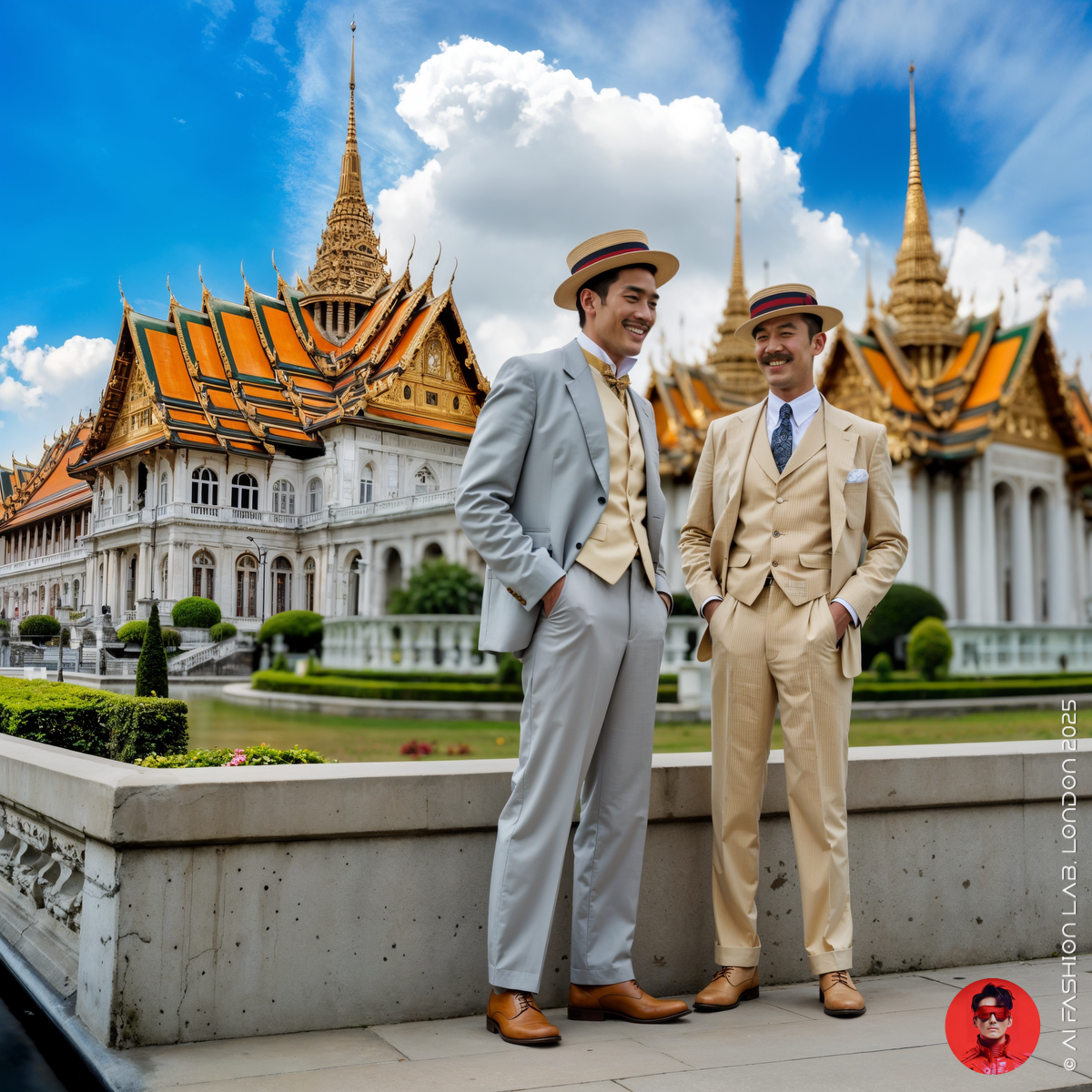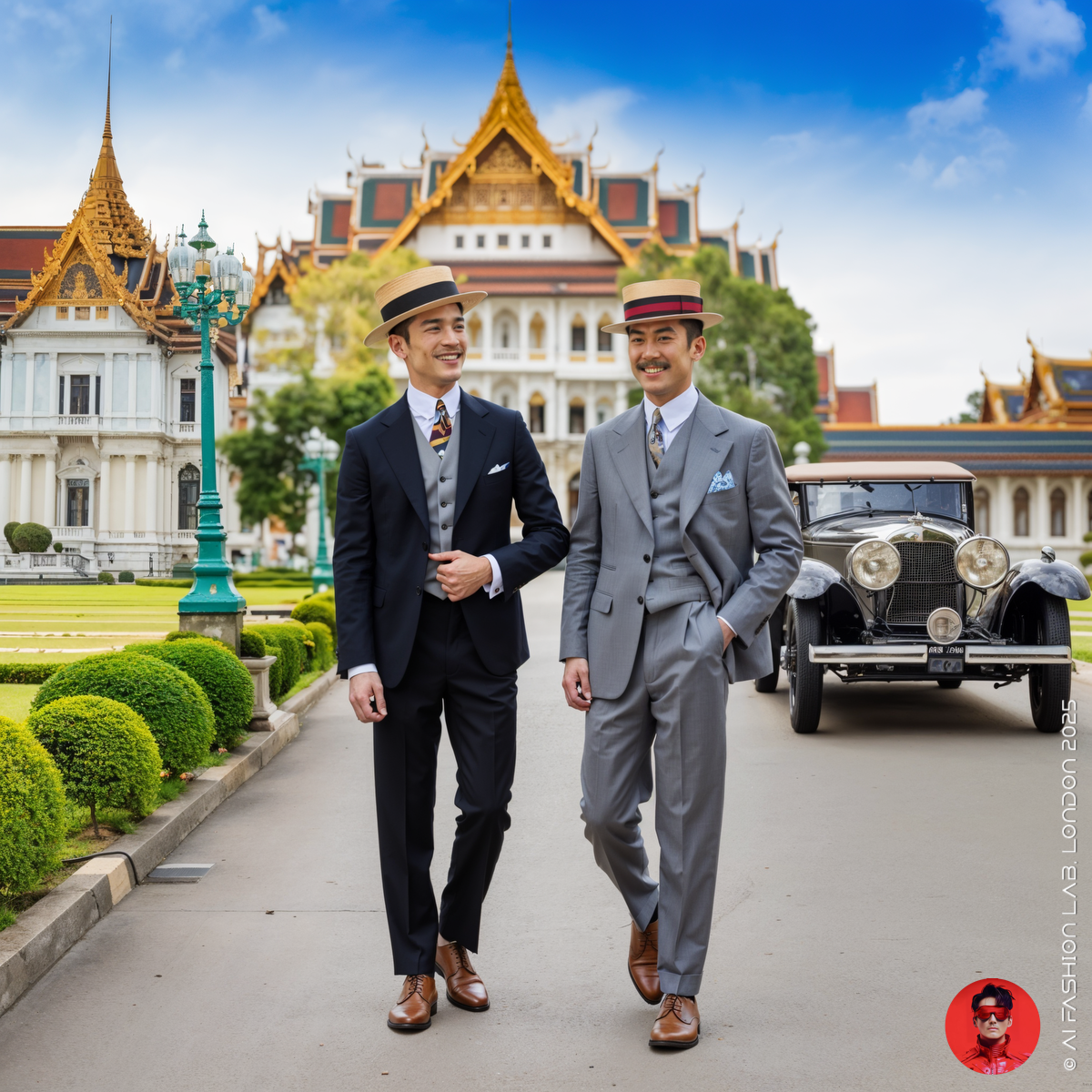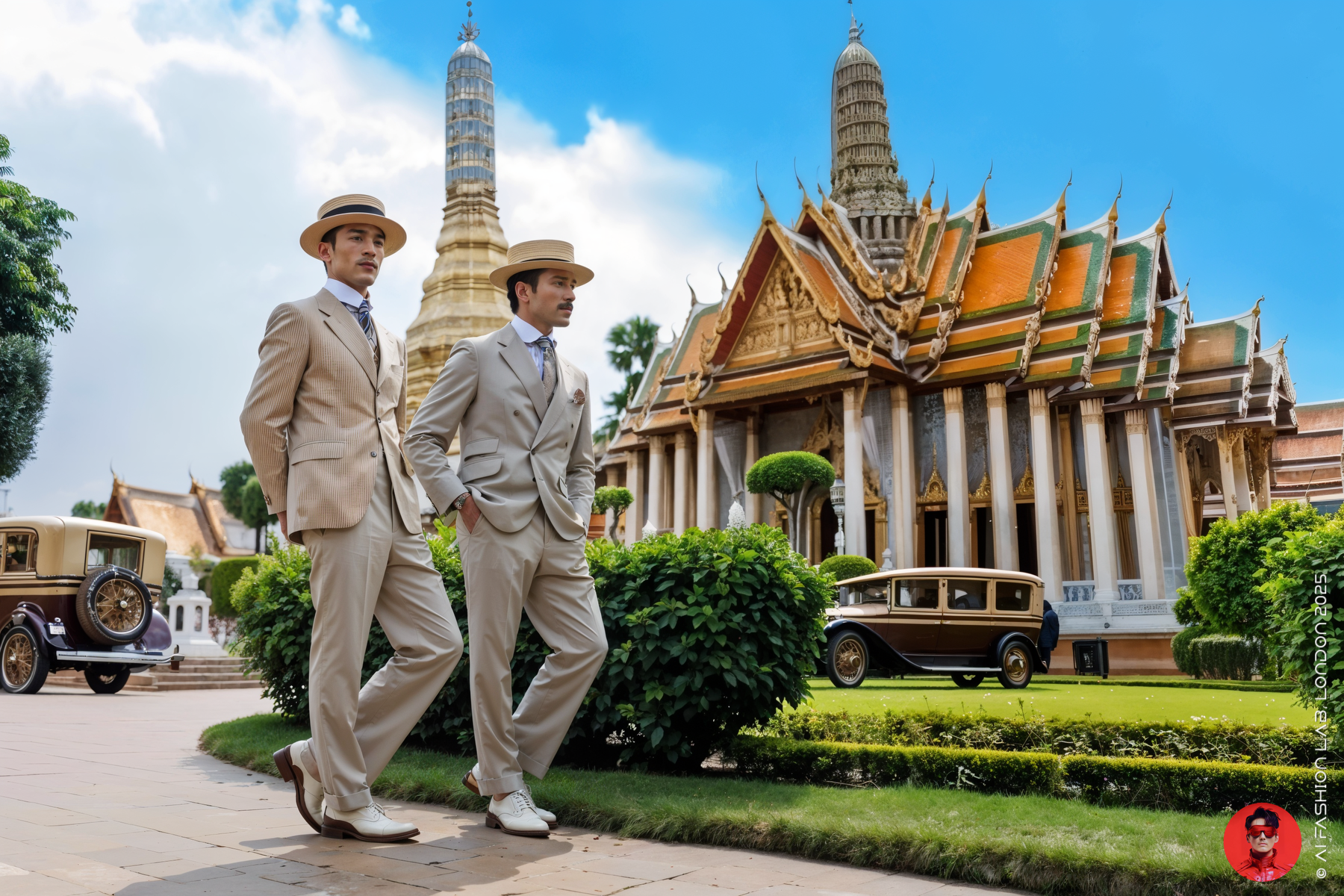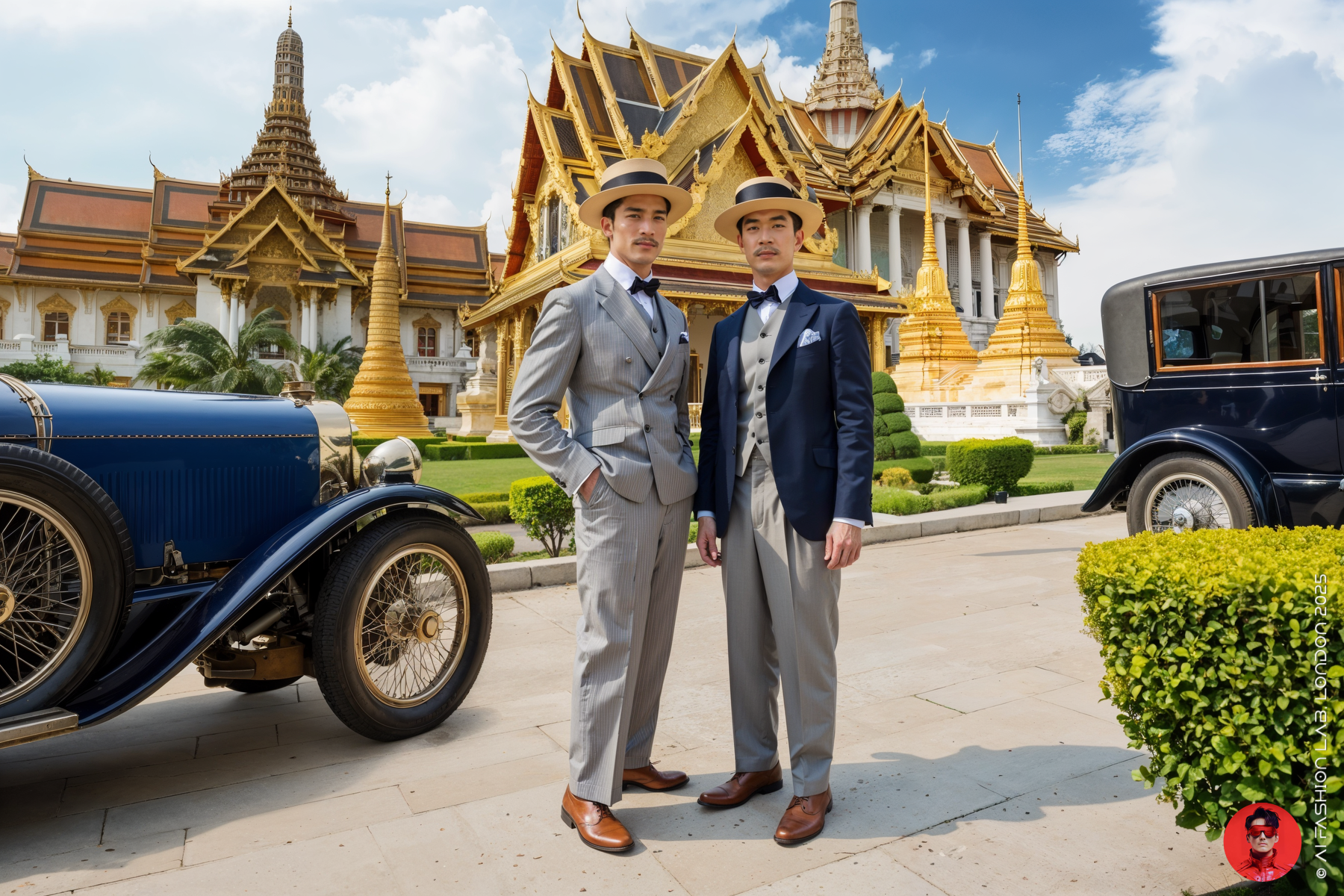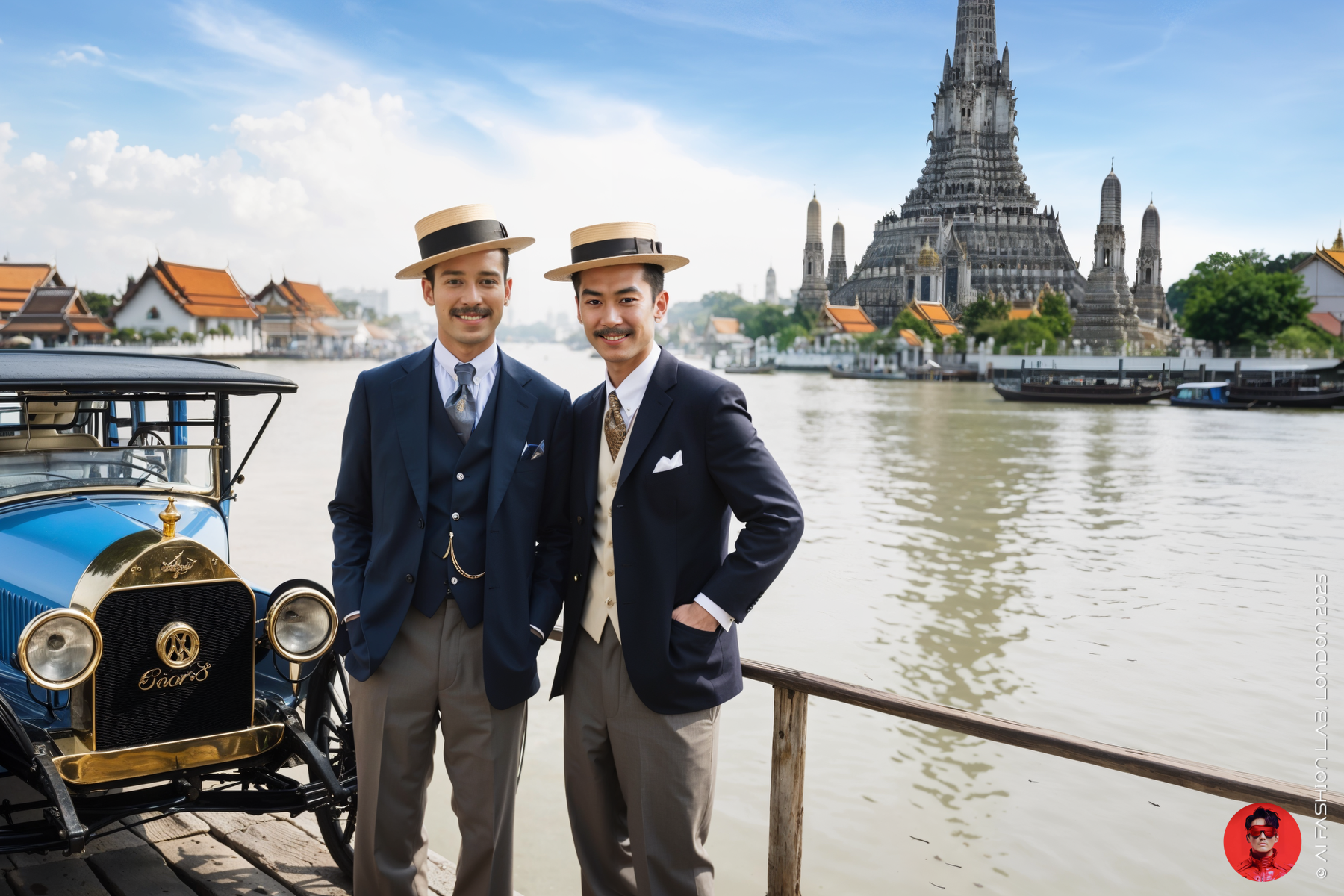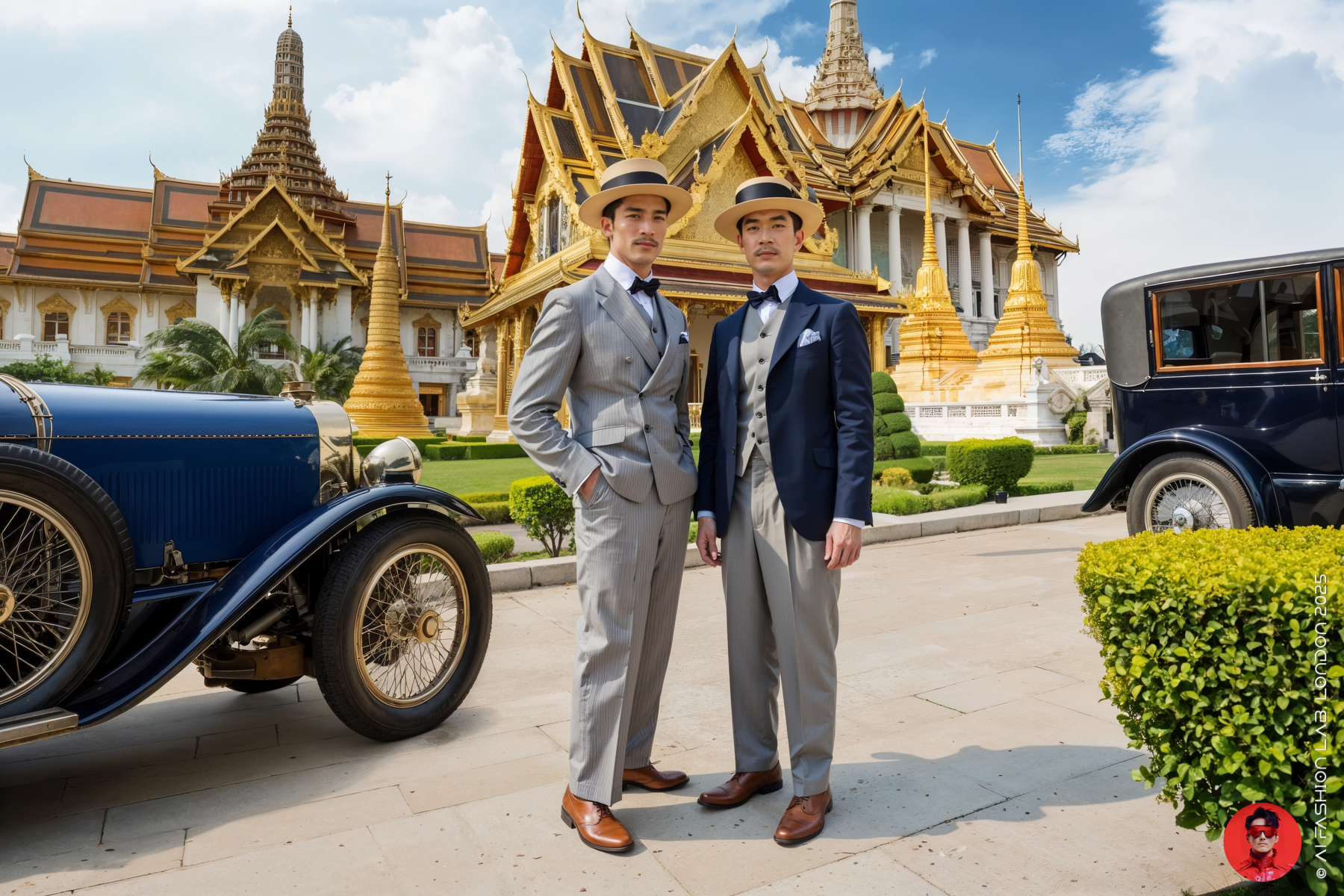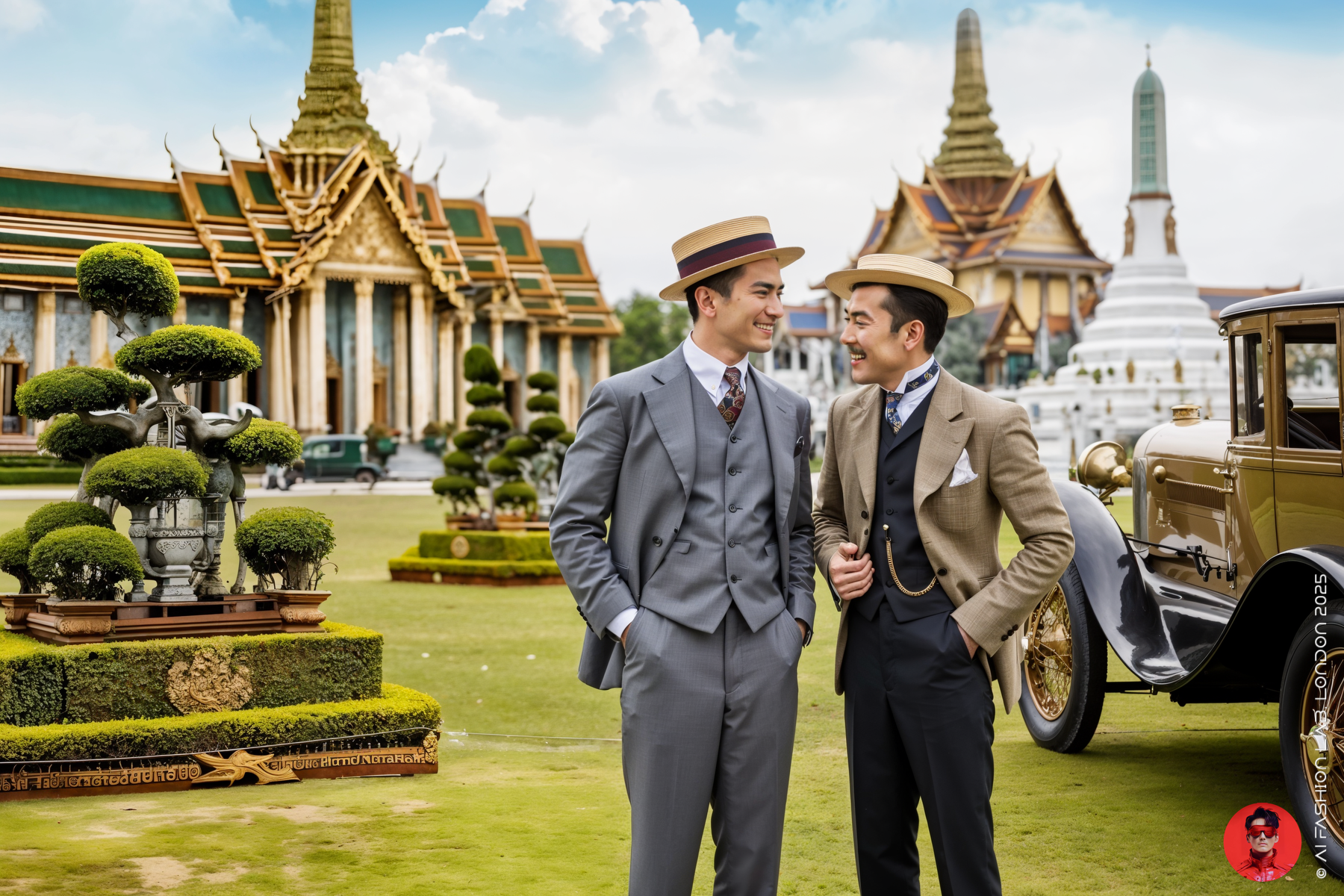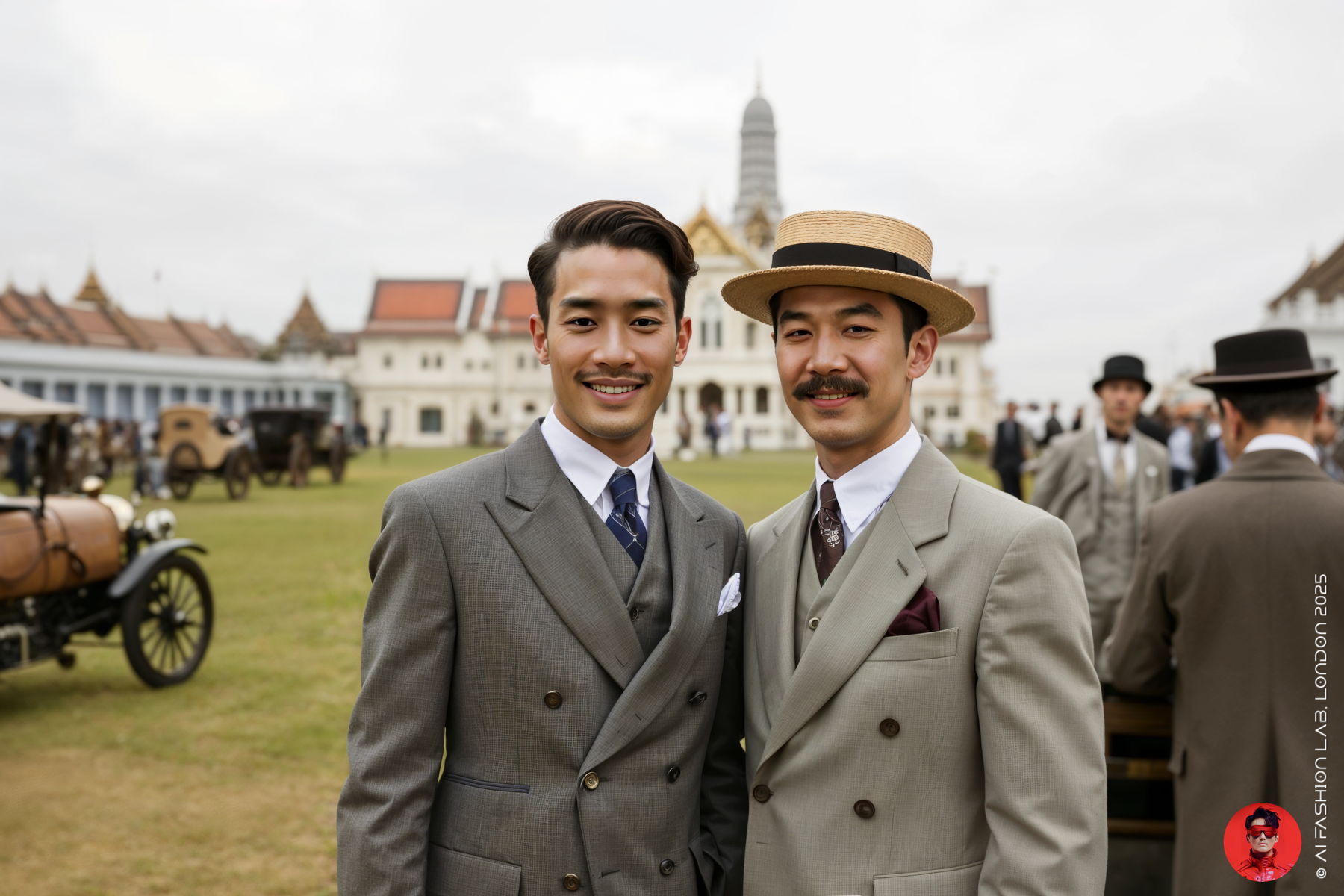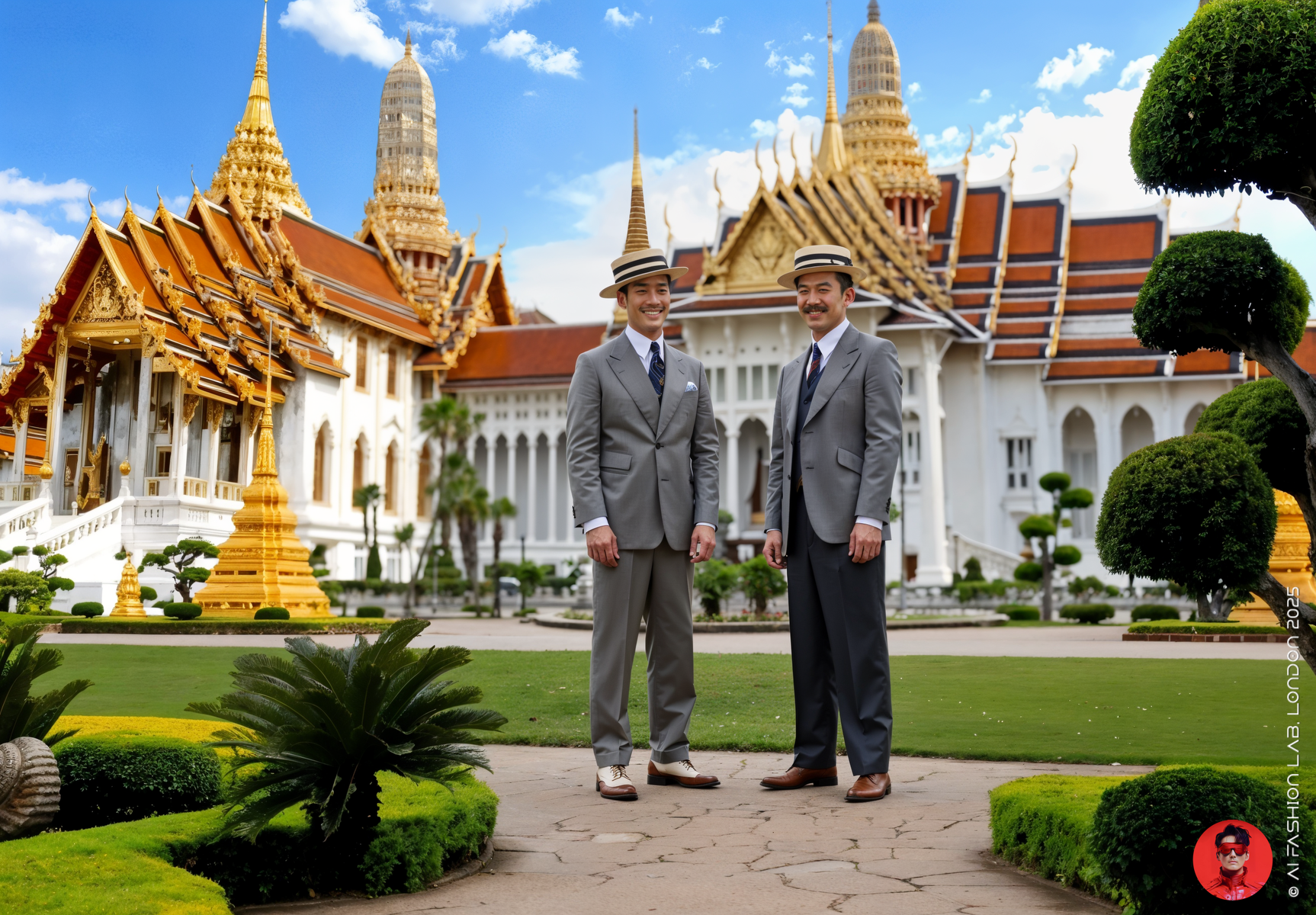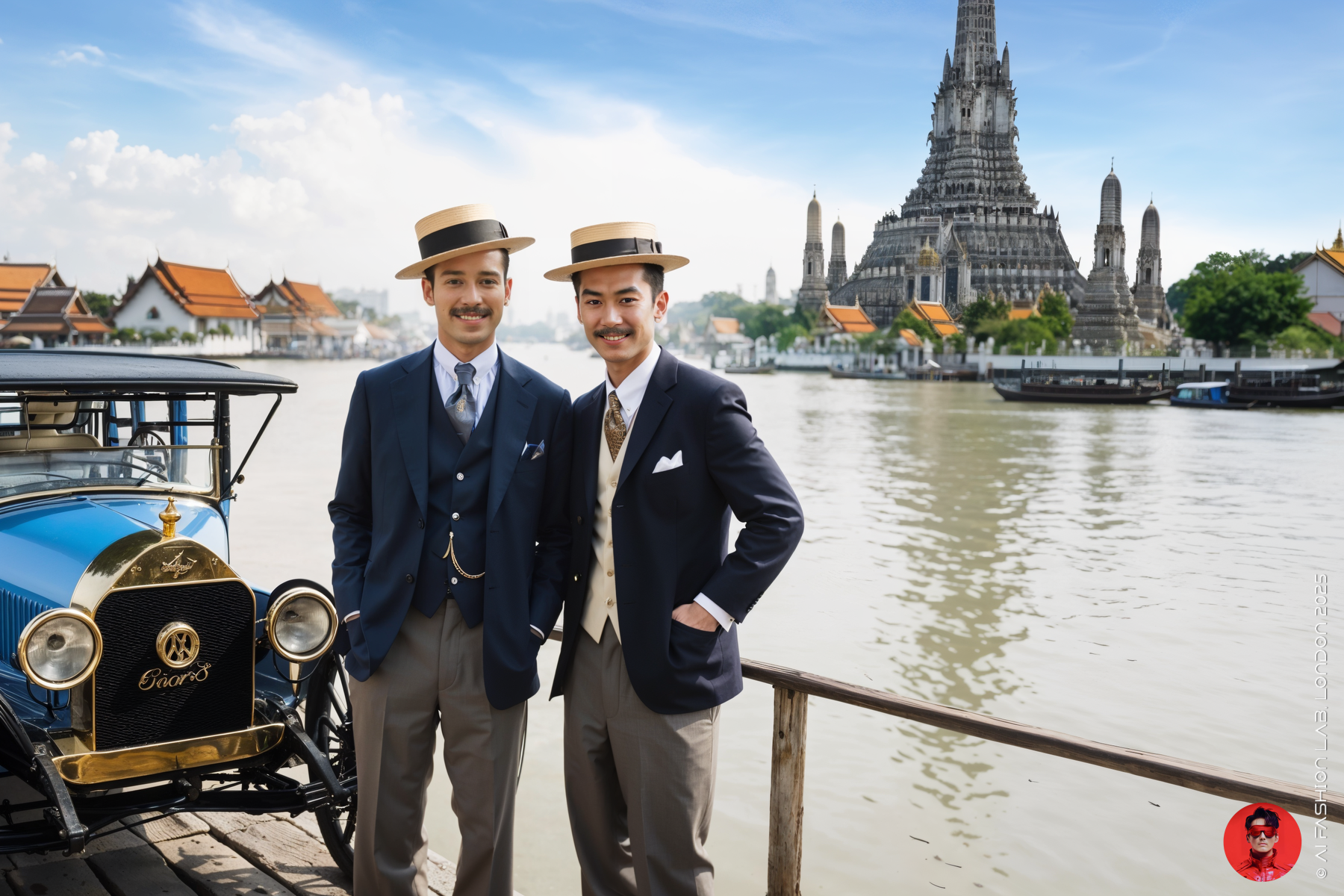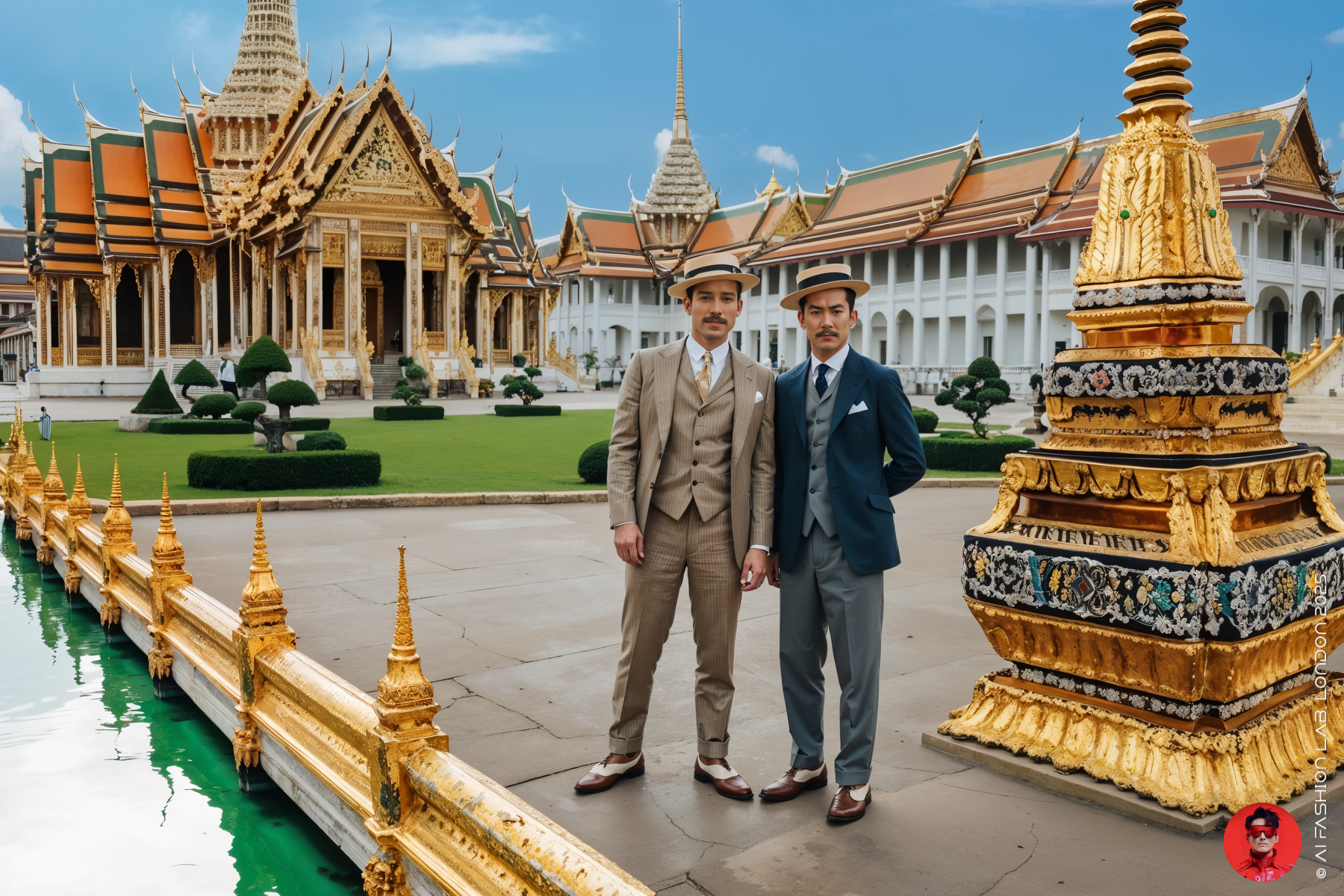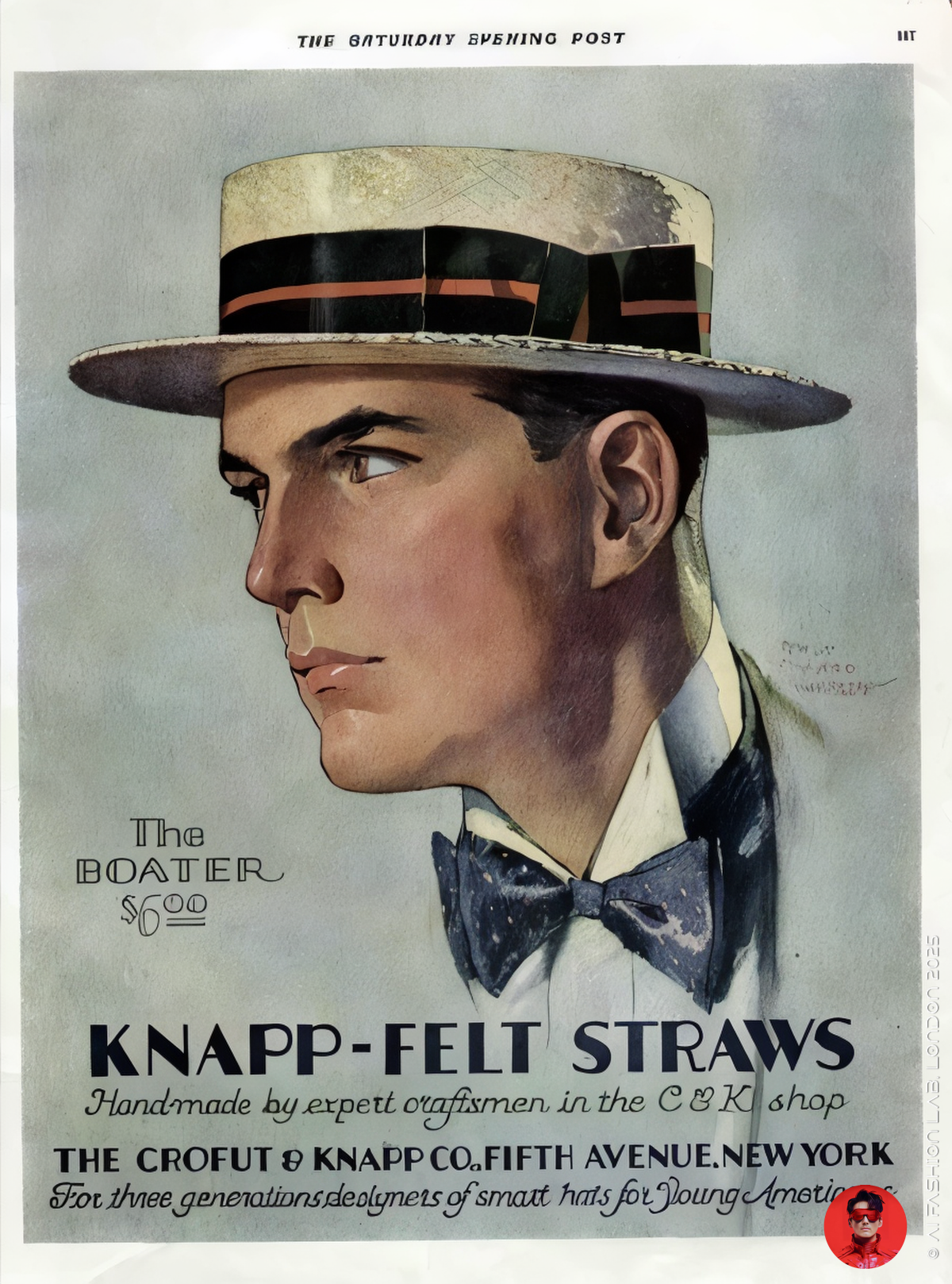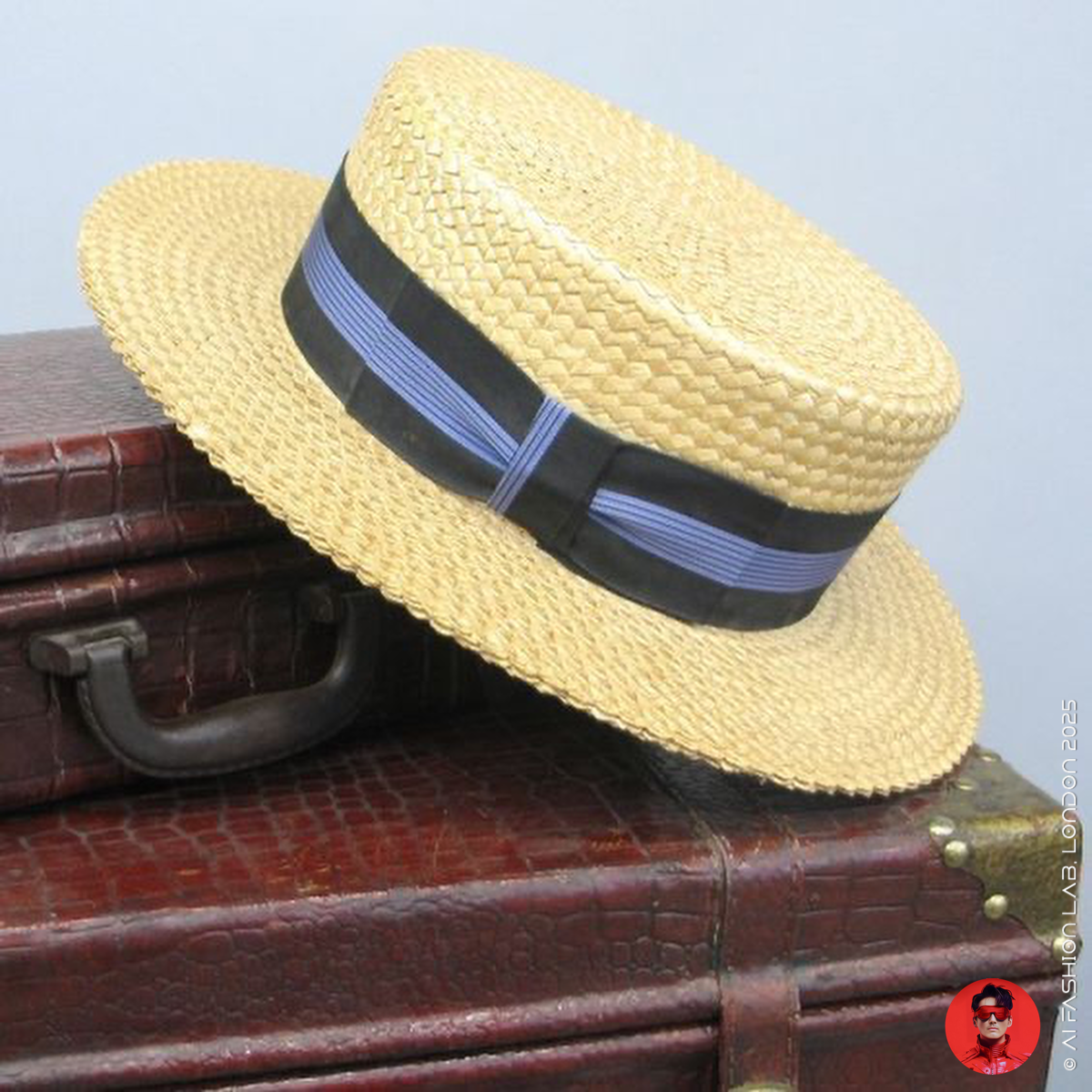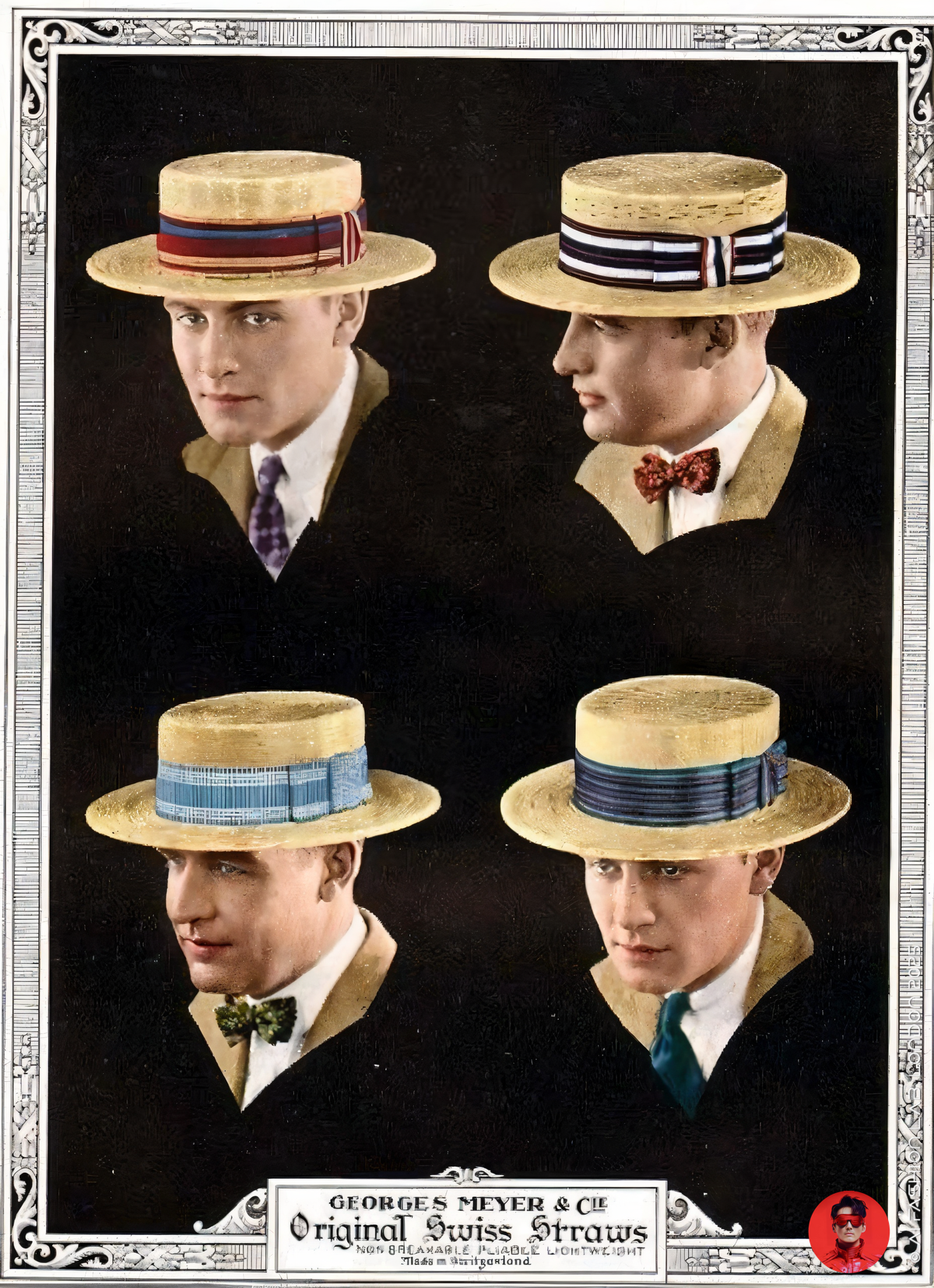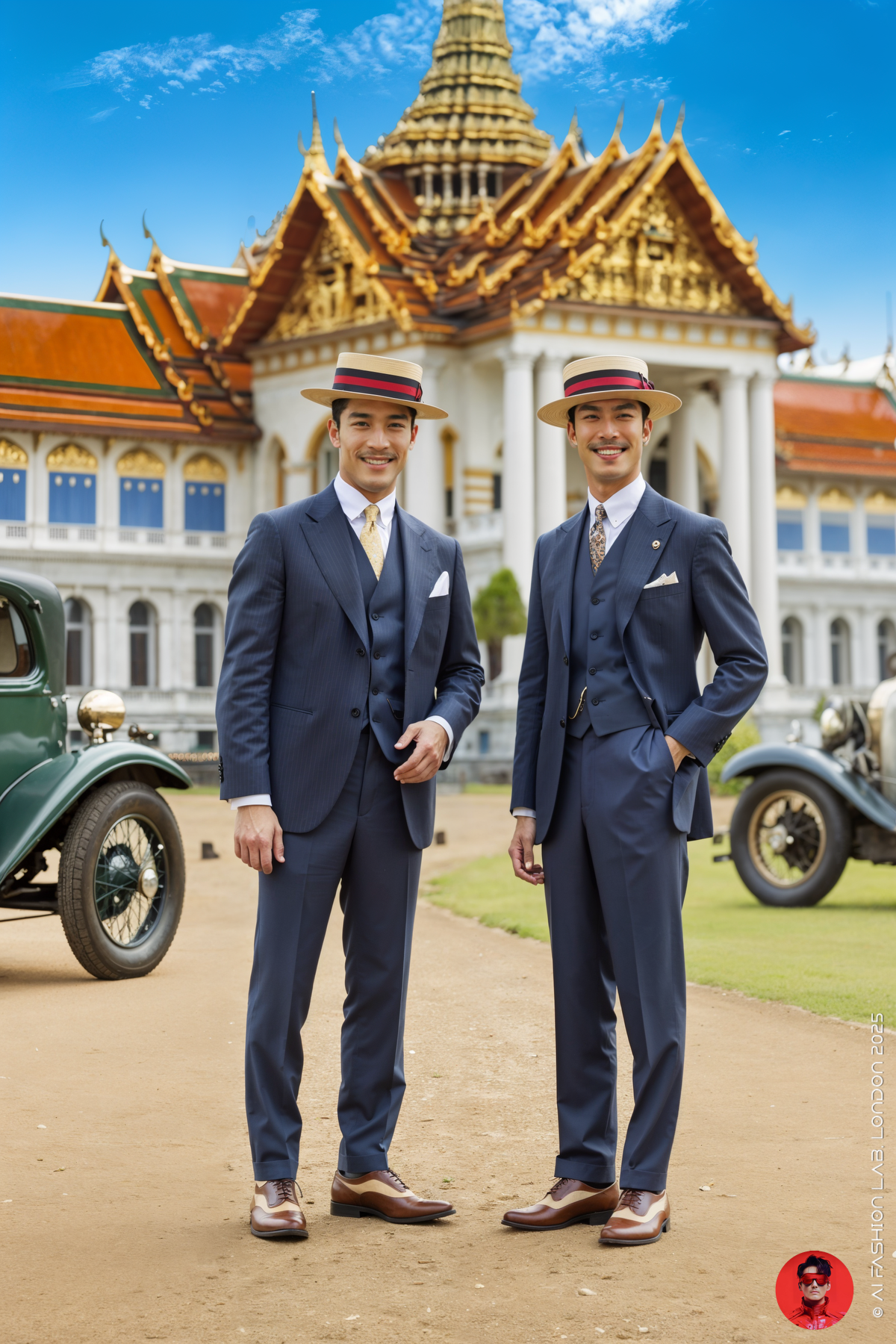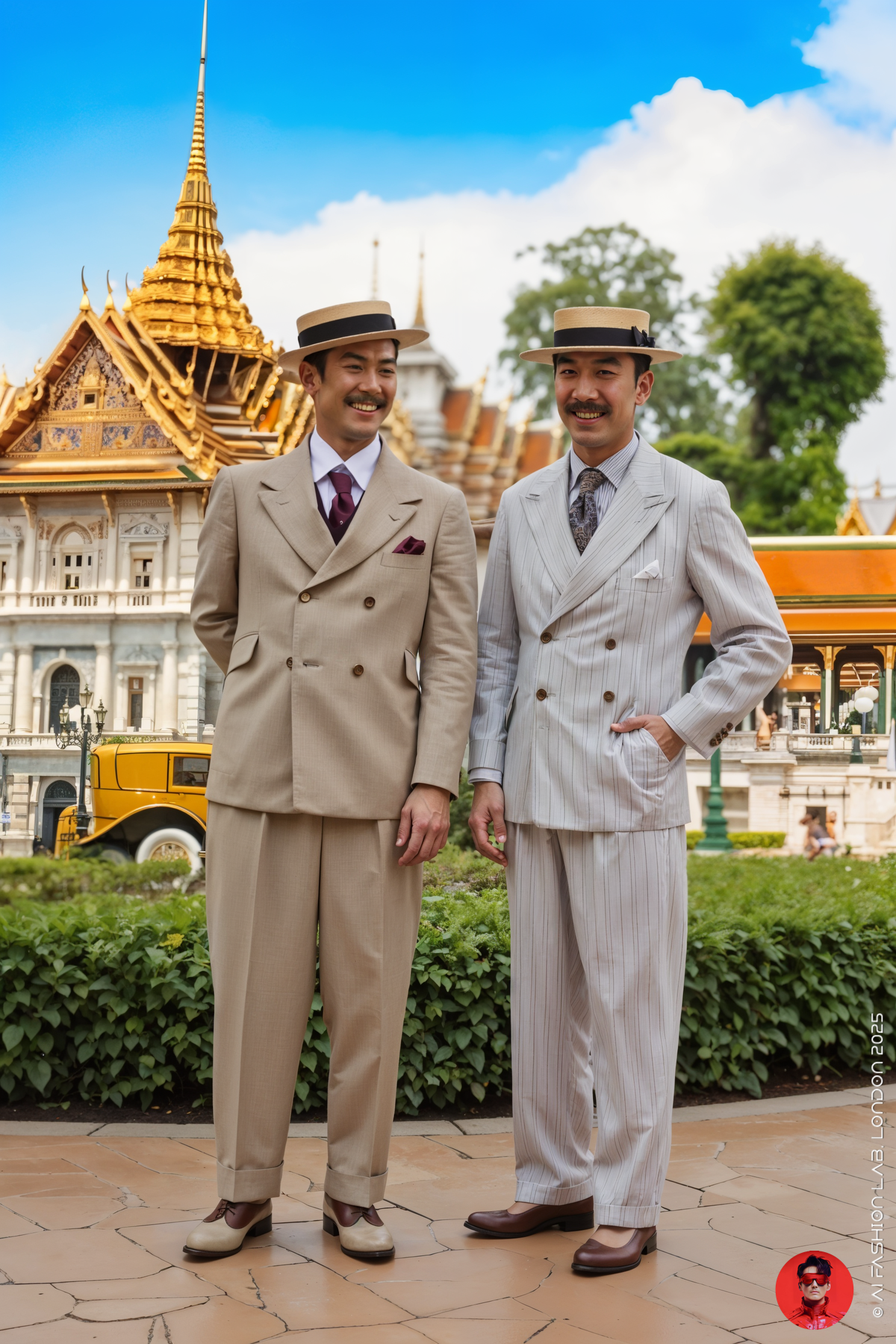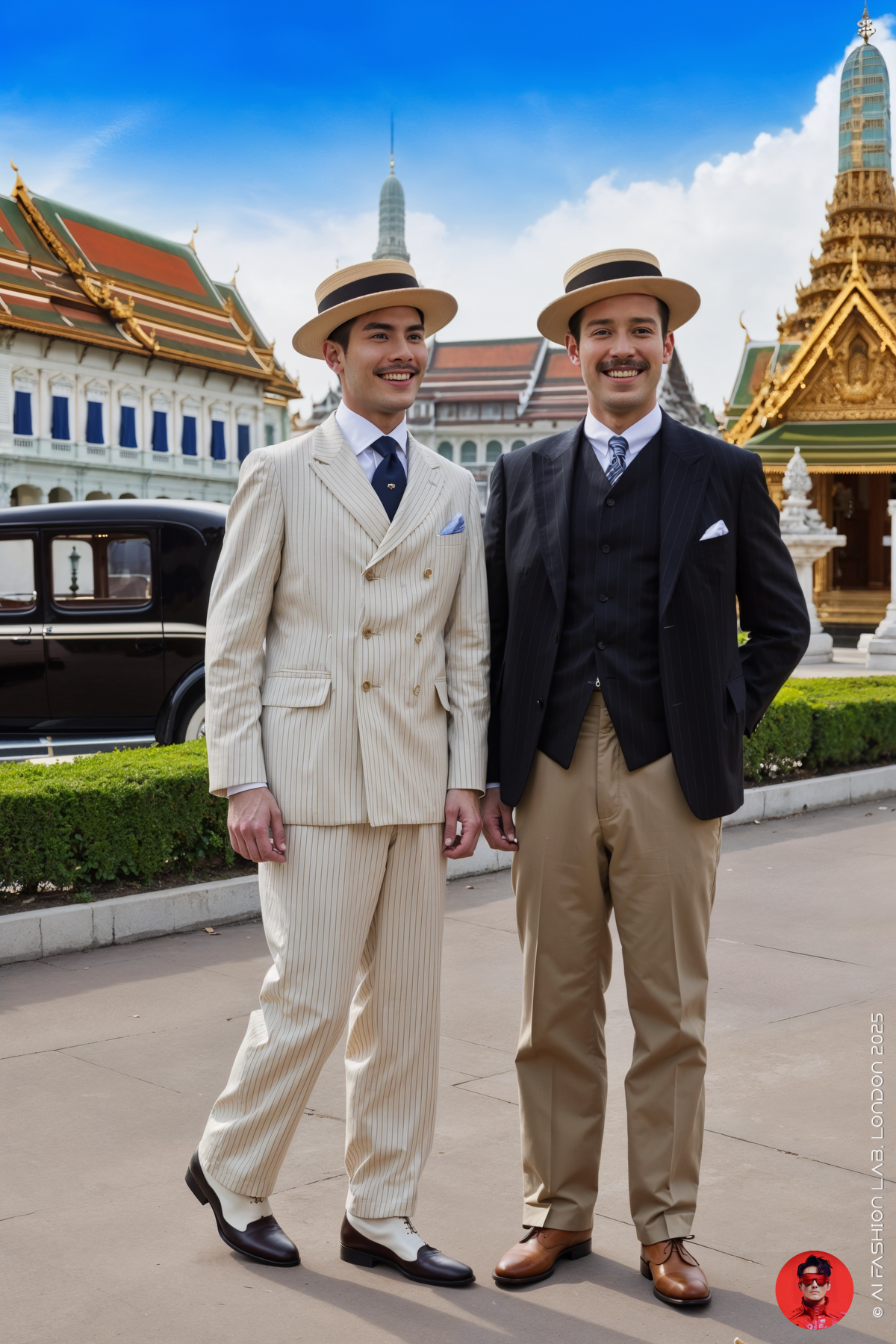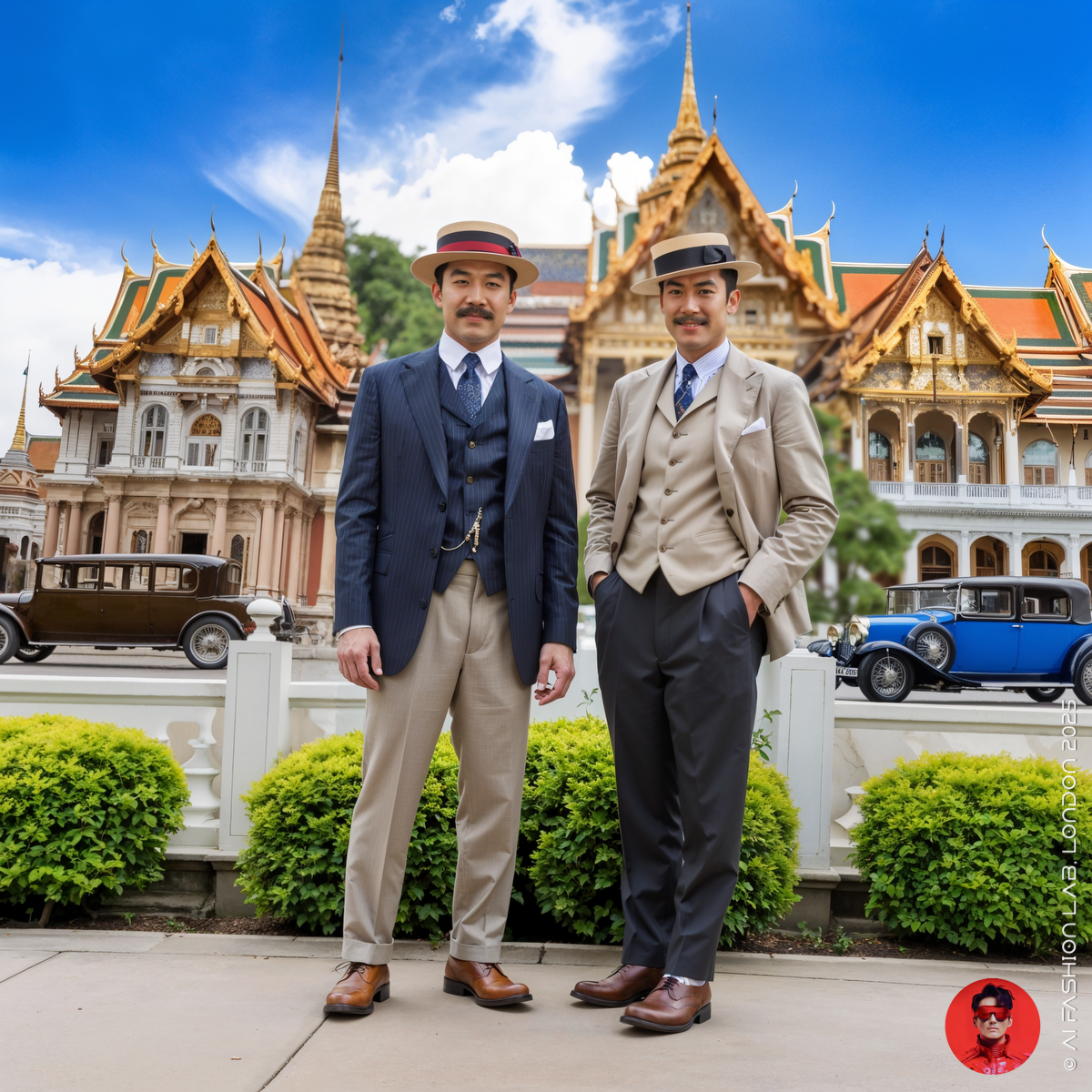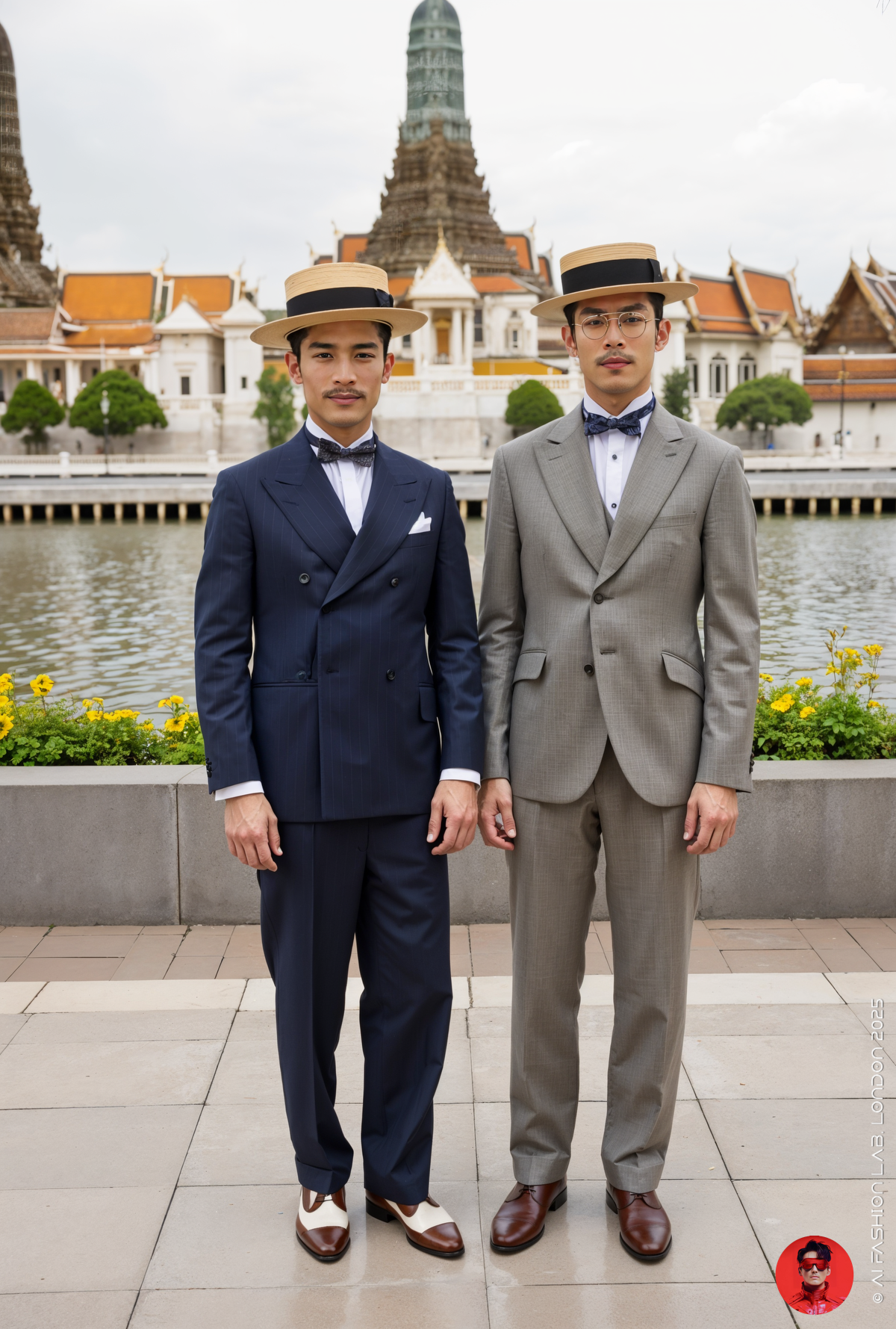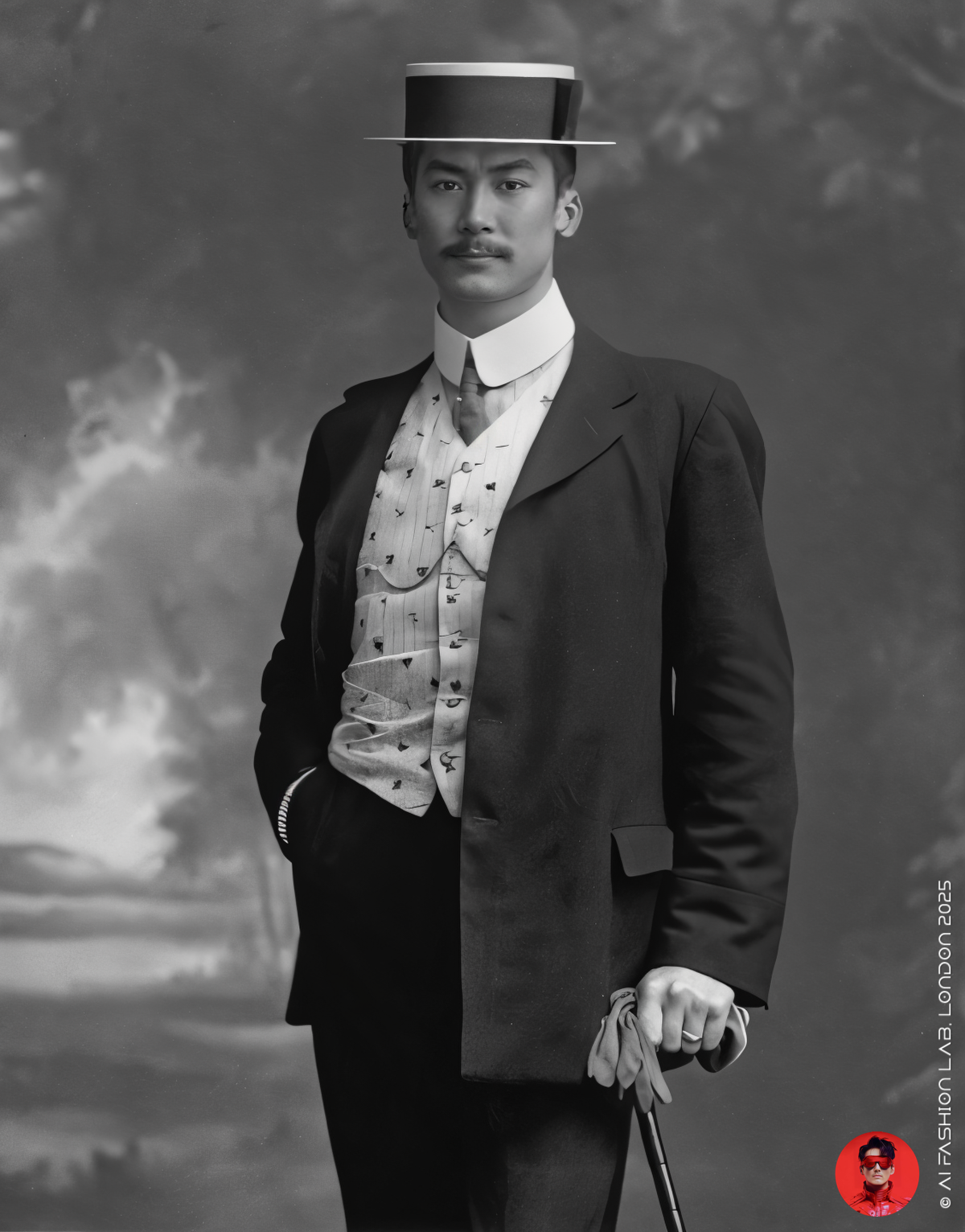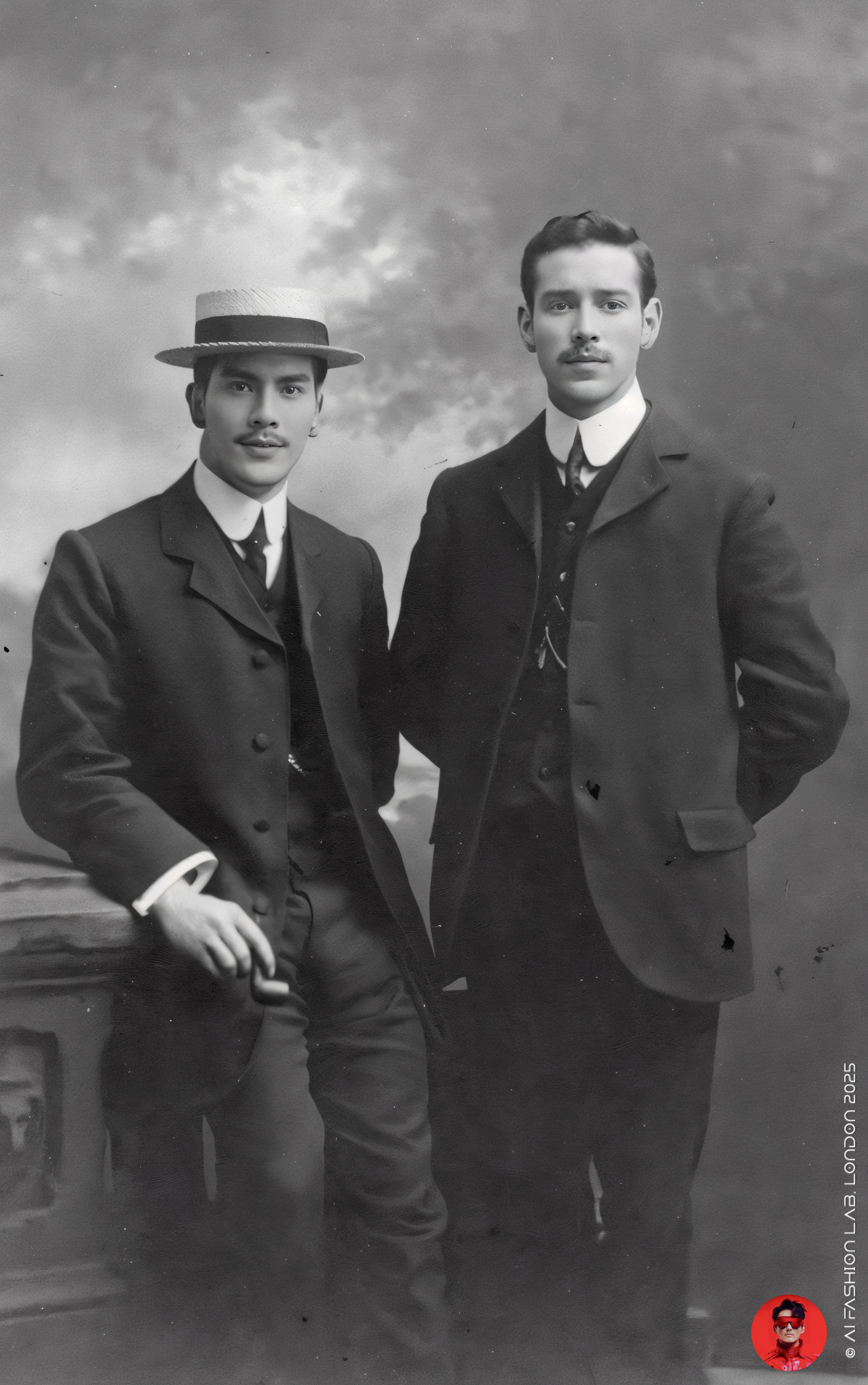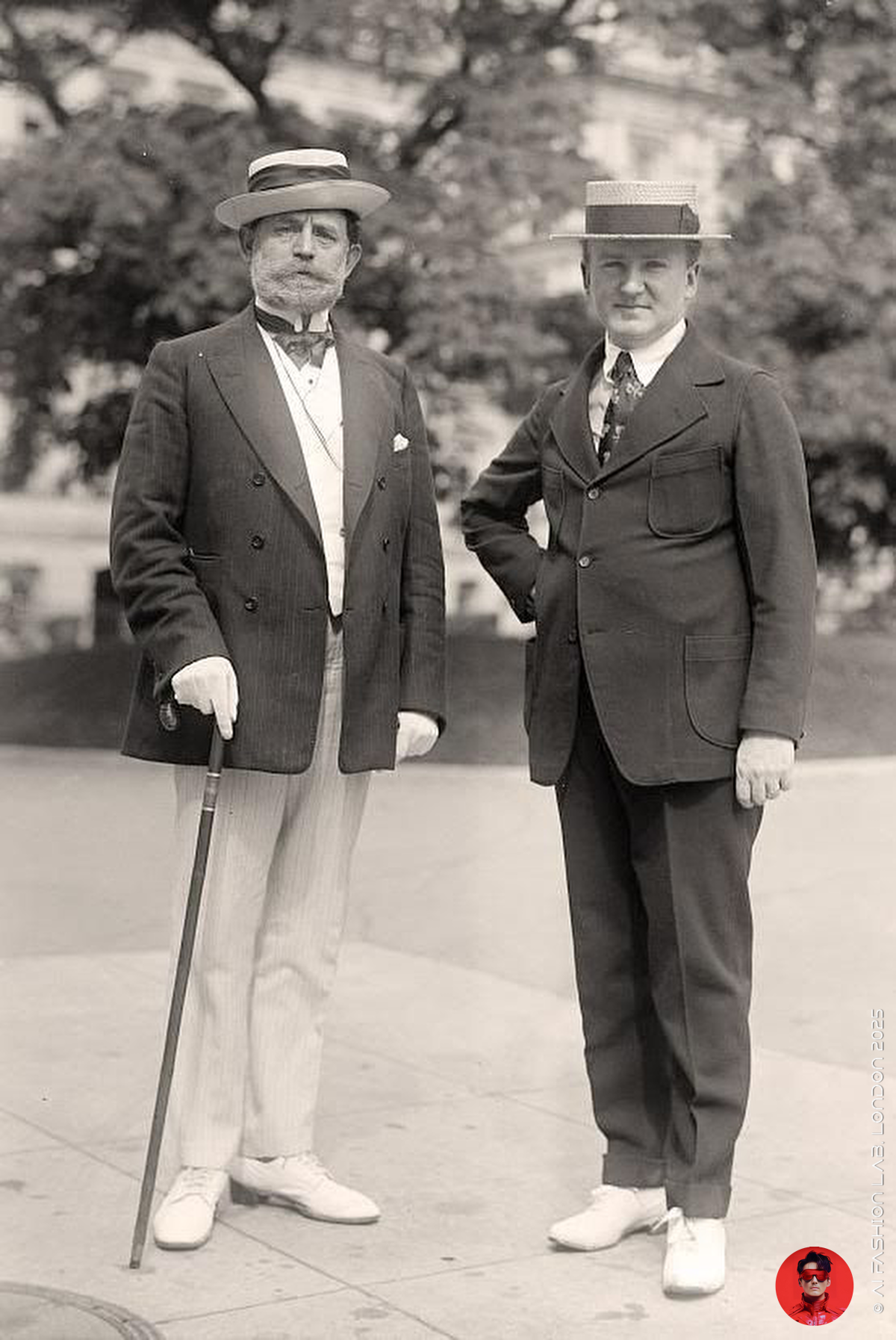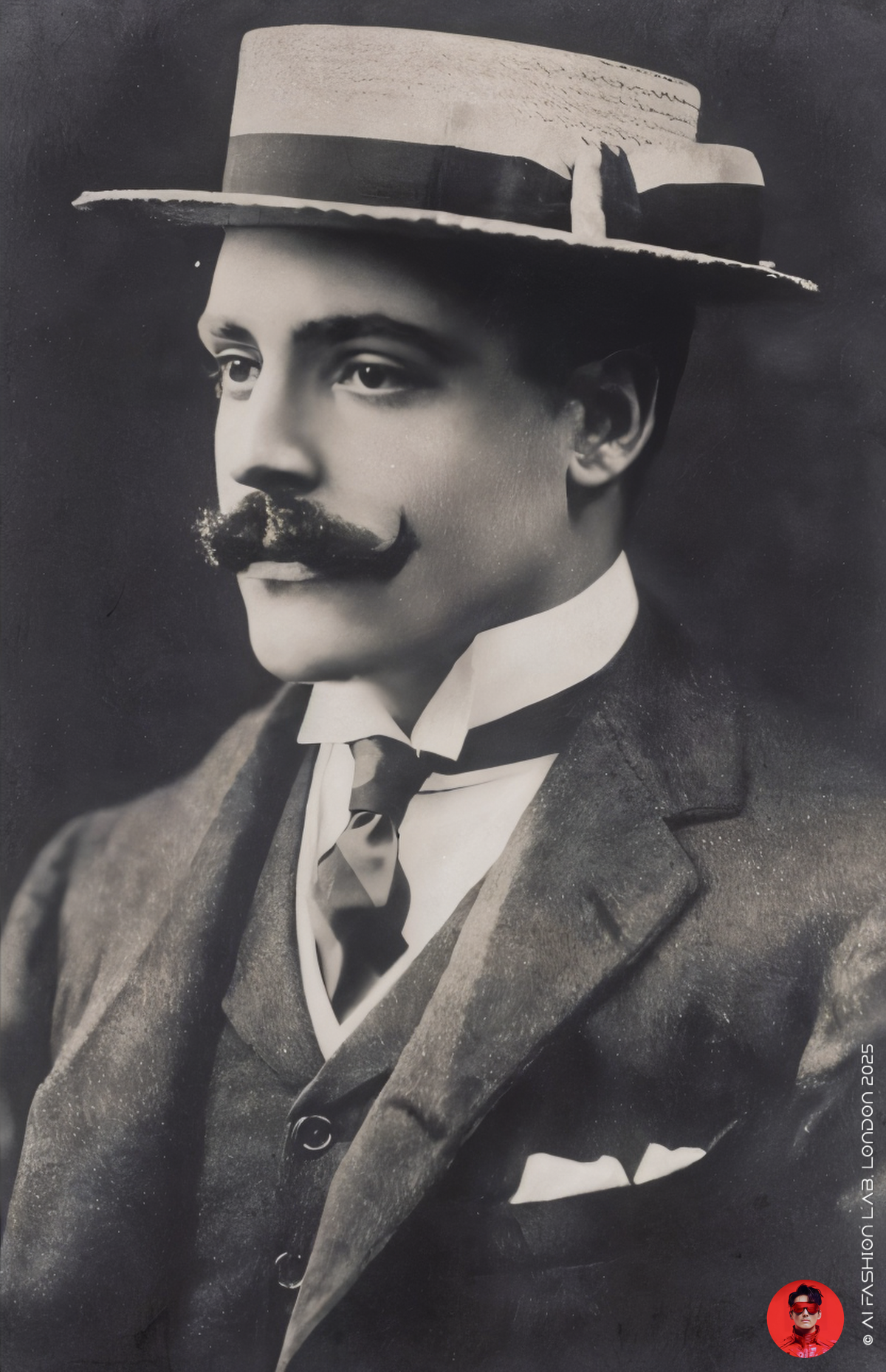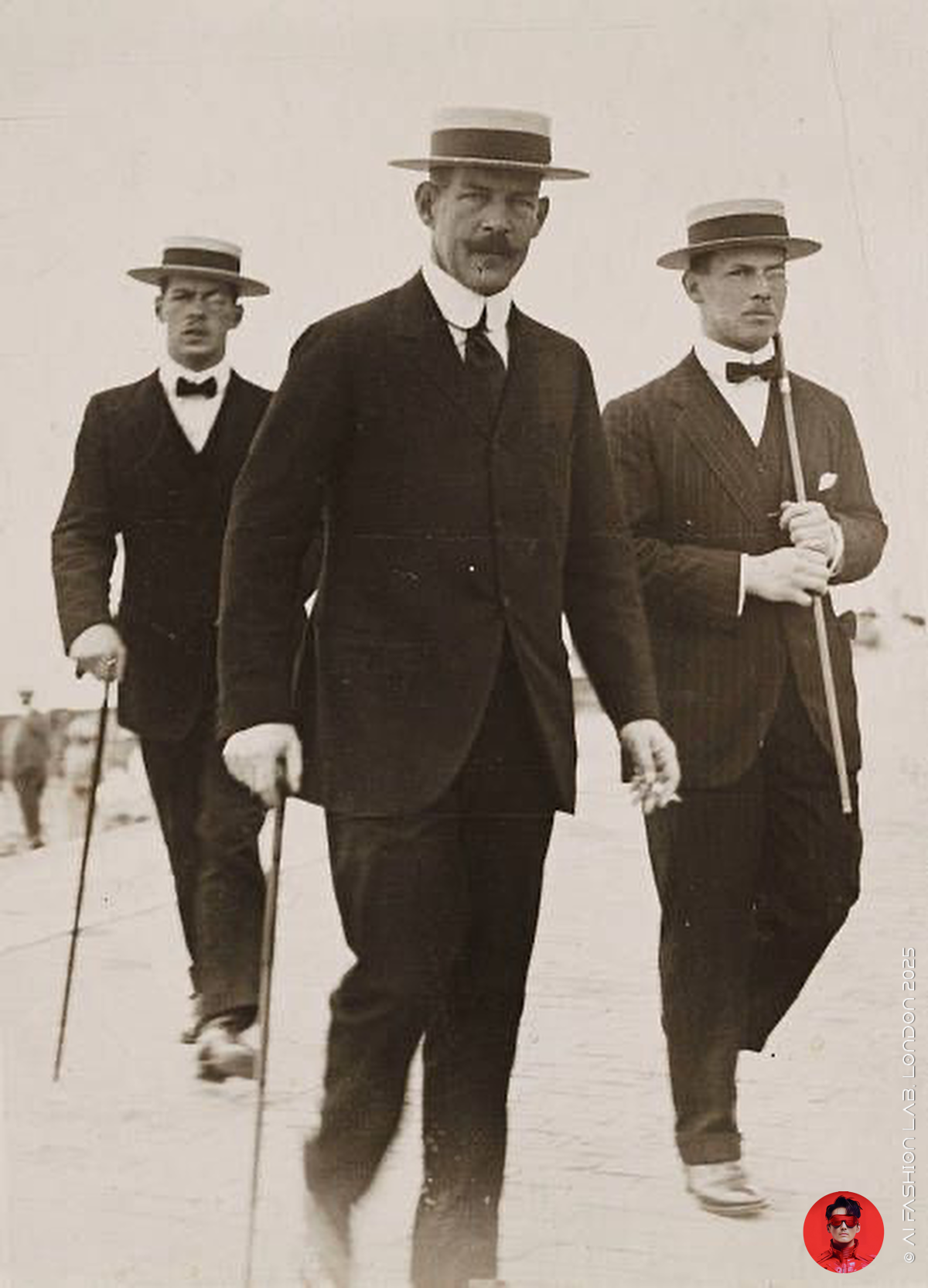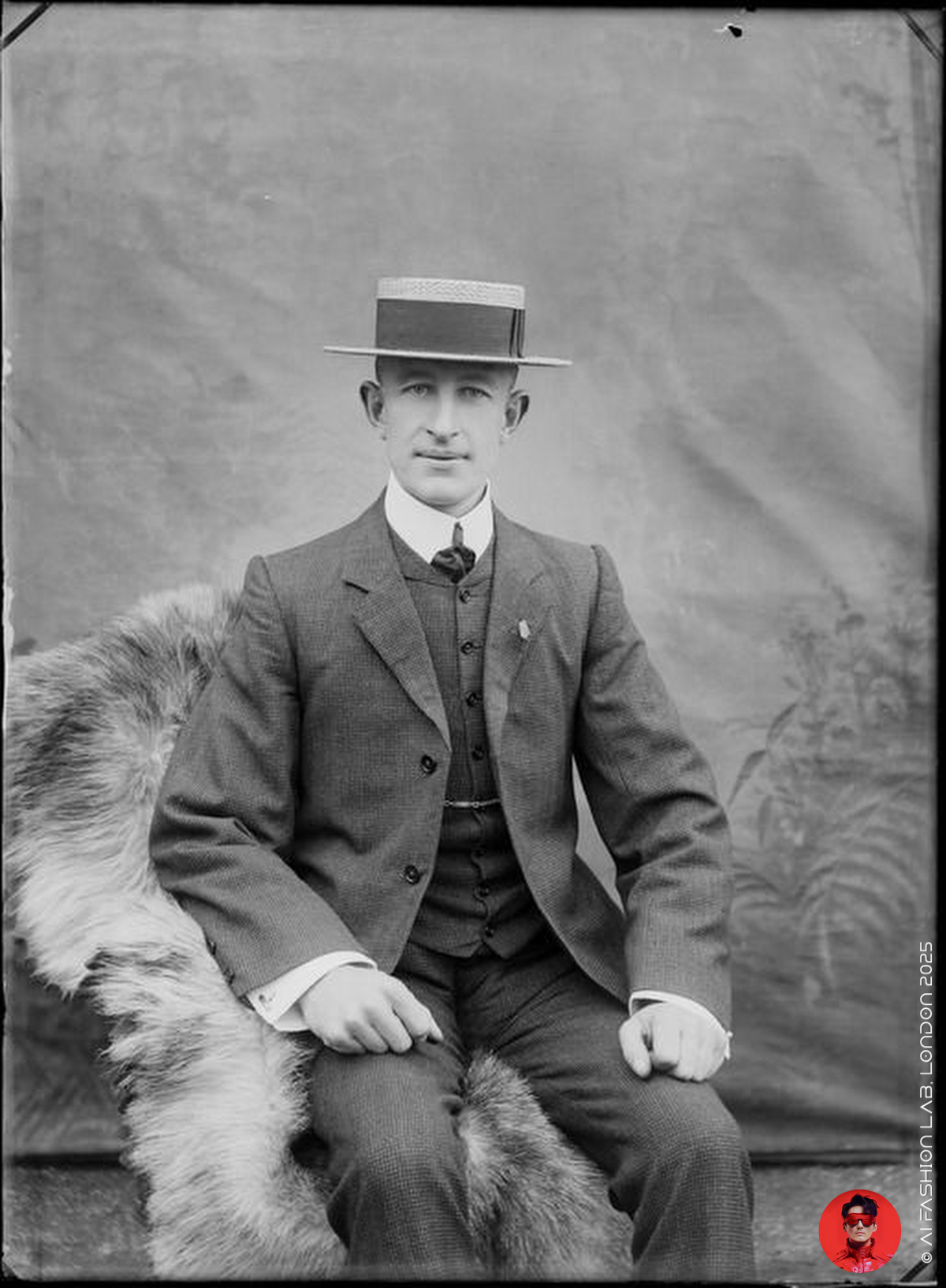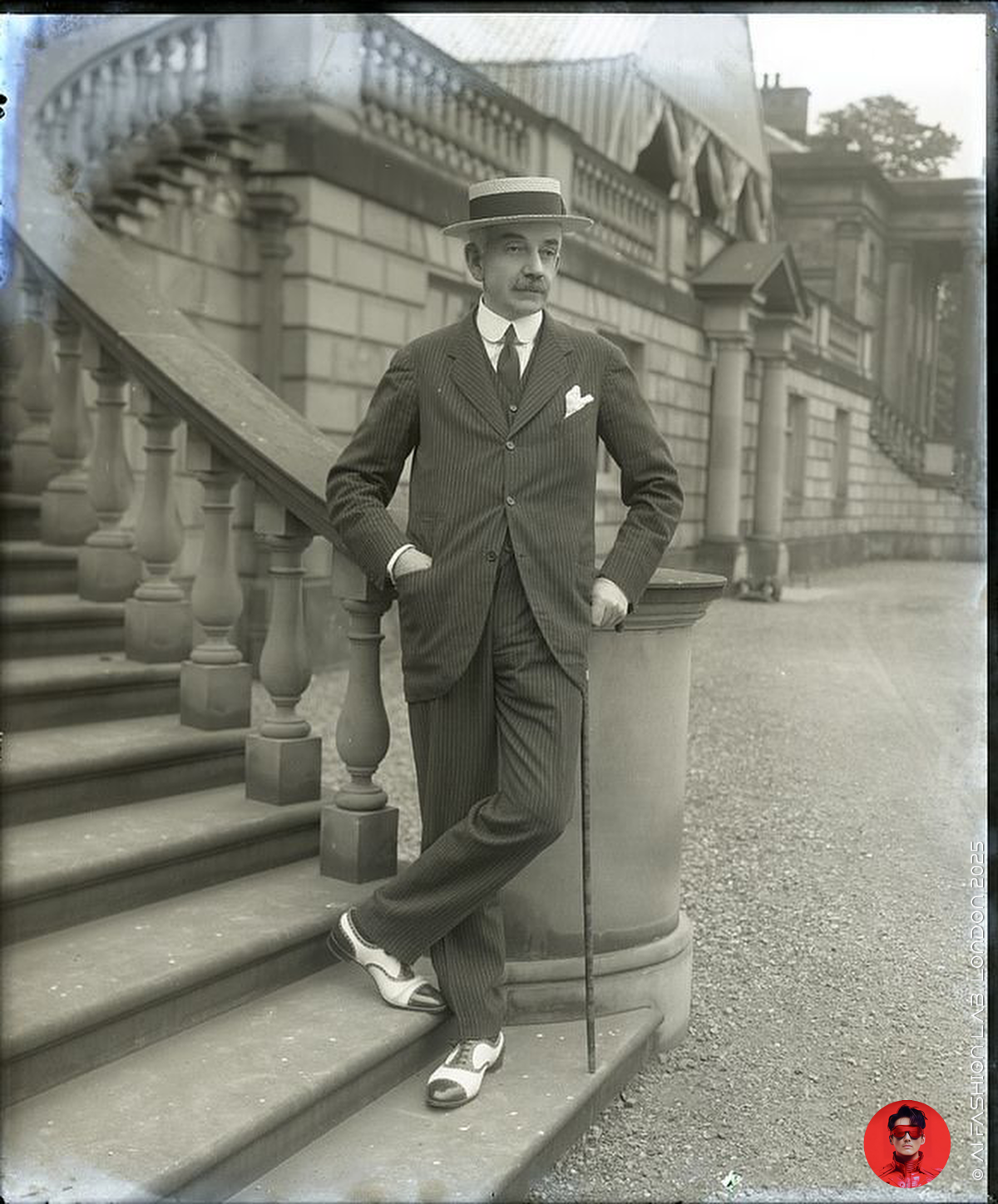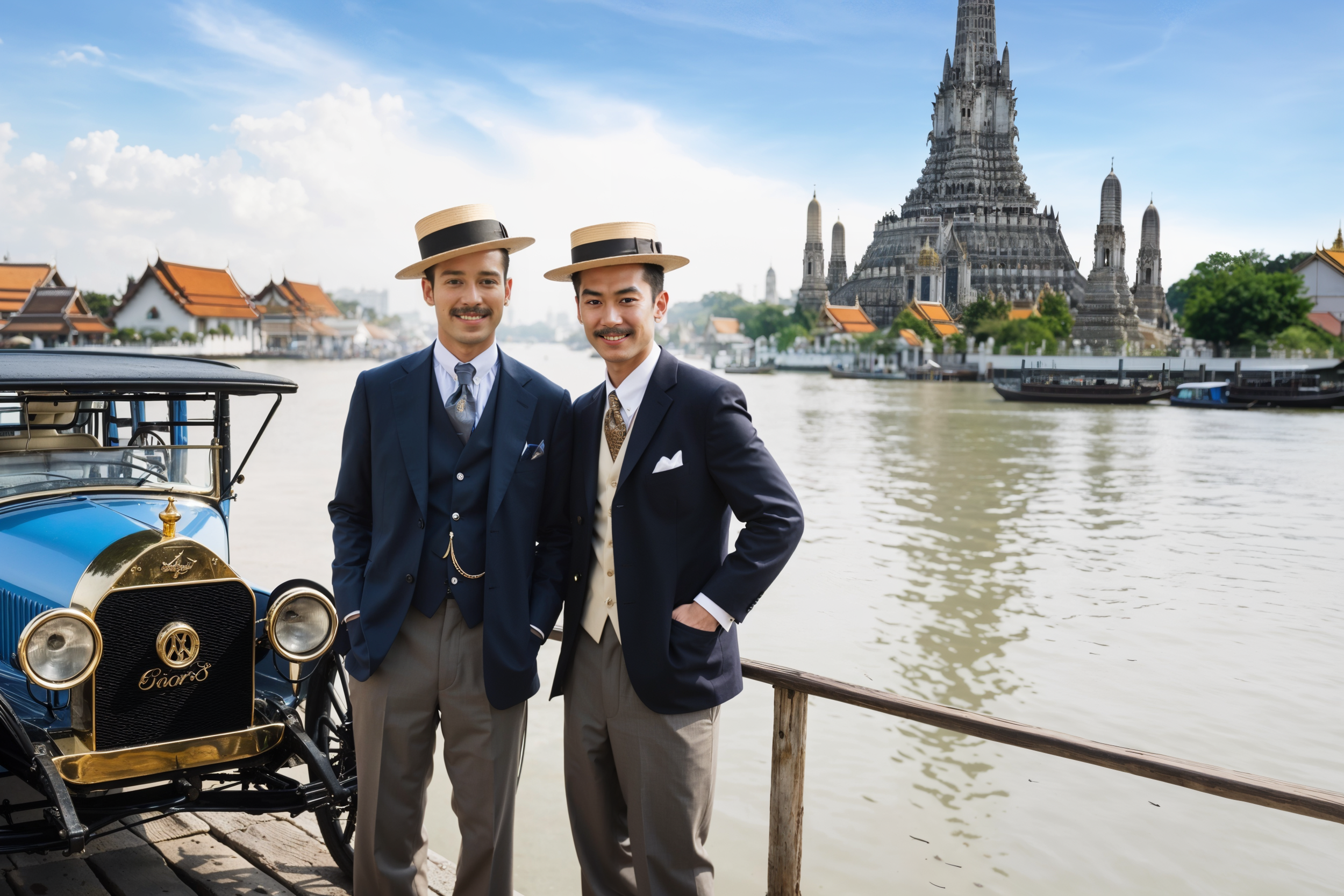จินตนาการแฟชั่นบุรุษแบบตะวันตกในสมัยรัชกาลที่ ๖ และหมวกโบ๊ตเตอร์
แฟชั่นบุรุษในสมัยรัชกาลที่ ๖ และหมวกโบ๊ตเตอร์: จินตนาการเมื่อสยามรับแฟชั่นตะวันตกอย่างเต็มตัว
ทศวรรษ 1920 คือช่วงเวลาแห่งความเปลี่ยนแปลงในโลกของแฟชั่นผู้ชาย เครื่องแต่งกายสะท้อนความสง่างาม ความมีโครงสร้าง และวิถีชีวิตที่เปิดรับความสบายมากขึ้น ภายหลังสงครามโลกครั้งที่ 1 ผู้ชายเริ่มลดความเป็นทางการของการแต่งกายลง แต่ยังคงรักษาความเนี้ยบและพิถีพิถันแบบสุภาพบุรุษไว้ ชุดสูทยังคงเป็นศูนย์กลางของเครื่องแต่งกาย แต่มีการปรับรูปทรงและเลือกใช้ผ้าที่เหมาะกับฤดูกาล โดยเฉพาะอย่างยิ่งในช่วงฤดูร้อนและกิจกรรมนันทนาการกลางแจ้ง
ในยุคนี้ หมวกใบหนึ่งที่โดดเด่นขึ้นมาอย่างเห็นได้ชัดคือ หมวกโบ๊ตเตอร์ (Boater Hat) ซึ่งเป็นหมวกฟางทรงแข็ง มีส่วนบนแบน ปีกแบน และตกแต่งด้วยริบบิ้นผ้ากรอสเกรน หมวกชนิดนี้กลายเป็นสัญลักษณ์ของการแต่งกายที่สุภาพเรียบร้อยในช่วงฤดูร้อน และยังสะท้อนภาพลักษณ์ของชายหนุ่มชนชั้นกลางผู้มีรสนิยมอีกด้วย
แฟชั่นชายยุค 1920: องค์ประกอบสำคัญ
ชุดสูท: ชุดสูทสามส่วนยังคงเป็นมาตรฐาน โดยมีกางเกงเอวสูง ขากว้าง เสื้อกั๊กเข้ารูป และเสื้อสูททรงไหล่กว้าง ผ้าที่ใช้มีทั้งผ้าขนสัตว์ในฤดูหนาว และผ้าลินินหรือผ้าระบายอากาศดีสำหรับฤดูร้อน
เสื้อเชิ้ตและปกเสื้อ: นิยมเสื้อสีขาวหรือสีอ่อน โดยปกเสื้อเป็นแบบถอดเปลี่ยนได้ เช่น ปกมนแบบ “คลับ คอลลาร์” (club collar) หรือปกแหลมแบบดั้งเดิม (spearpoint collar) ในช่วงกลางทศวรรษเริ่มมีการใช้ปกอ่อนที่สะดวกสบายมากขึ้น
เนกไทและเครื่องประดับ: ลวดลายบนเนกไทมีความกล้าหาญ เช่น ลายทาง ลายศิลปะแบบ Art Deco พร้อมด้วยผ้าเช็ดหน้ากระเป๋า เข็มกลัดเนกไท และดอกไม้กลัดหน้าอก
รองเท้า: นิยมรองเท้าหนังผิวมัน หรือแบบสองสี (two-tone brogues)
หมวก: เป็นสิ่งที่ขาดไม่ได้ในการแต่งกายของชายยุคนั้น หมวกเฟโดราและฮอมบวร์กใช้ในฤดูหนาวหรือในโอกาสทางการ ส่วนหมวกโบ๊ตเตอร์คือเครื่องแต่งกายสำหรับฤดูร้อนที่ได้รับความนิยมสูงสุด
หมวกโบ๊ตเตอร์: จากริมแม่น้ำสู่สัญลักษณ์แฟชั่นสากล
หมวกโบ๊ตเตอร์ หรือที่รู้จักกันอีกชื่อว่า “sennit hat” ถือกำเนิดขึ้นในอังกฤษช่วงกลางศตวรรษที่ 19 โดยเป็นหมวกฟางแบบแข็งที่ใช้ในกิจกรรมพายเรือของนักเรียนชายตามมหาวิทยาลัย โดยเฉพาะอย่างยิ่งใน มหาวิทยาลัยเคมบริดจ์ และ อ็อกซ์ฟอร์ด
แม้จะไม่มีชื่อของช่างทำหมวกคนใดที่ได้รับการจดจำว่าเป็นผู้ประดิษฐ์หมวกชนิดนี้อย่างชัดเจน แต่ก็ทราบกันดีว่าหมวกโบ๊ตเตอร์แพร่หลายโดยช่างทำหมวกในอังกฤษตอนใต้ โดยเฉพาะในลอนดอน ซึ่งเป็นผู้รับทำหมวกให้แก่นักเรียนชายและกลุ่มชนชั้นกลางผู้รักกิจกรรมกลางแจ้ง หมวกนี้จึงเริ่มเป็นส่วนหนึ่งของชุดยูนิฟอร์มของชมรมพายเรือของมหาวิทยาลัย และกลายเป็นเครื่องแต่งกายประจำการออกเรือเล่นหรือร่วมกิจกรรมฤดูร้อนอื่น ๆ
คำว่า “boater” ที่ใช้เรียกหมวกนี้ มาจากกิจกรรม “boating” ซึ่งเป็นหนึ่งในกิจกรรมสันทนาการยอดนิยมของนักเรียนชายในยุคนั้น หมวกจึงถูกใช้ทั้งในงานแข่งขันเรือ งานเลี้ยงริมน้ำ และการเดินเล่นในช่วงฤดูร้อน หมวกโบ๊ตเตอร์ยังได้รับความนิยมในหมู่นักเรียนชายจากโรงเรียนชื่อดังในอังกฤษ เช่น Eton College, Harrow, และ Winchester ซึ่งล้วนมีเครื่องแบบที่รวมหมวกโบ๊ตเตอร์เข้าไว้ด้วย
ภายในไม่กี่ทศวรรษ หมวกโบ๊ตเตอร์ก็เริ่มหลุดออกจากบริบทเฉพาะกิจกรรมพายเรือ กลายเป็นสัญลักษณ์ของการพักผ่อนอย่างมีรสนิยมในยุค เอ็ดเวิร์เดียน (ต้นคริสต์ศตวรรษที่ 20) และยังคงได้รับความนิยมอย่างสูงต่อเนื่องในยุค 1920s ทั้งในอังกฤษ ยุโรป และสหรัฐอเมริกา หมวกชนิดนี้มักสวมคู่กับเบลเซอร์ กางเกงลายทาง และรองเท้า spectator shoes กลายเป็นลุคของสุภาพบุรุษผู้มีรสนิยมในช่วงฤดูร้อน
เมื่อแฟชั่นตะวันตกเดินทางมาถึงสยาม: ภาพในจินตนาการจากสมัยรัชกาลที่ 6
ในช่วงต้นคริสต์ศตวรรษที่ 20 ภายใต้รัชสมัยของ พระบาทสมเด็จพระจุลจอมเกล้าเจ้าอยู่หัว (รัชกาลที่ 5) และต่อเนื่องถึง พระบาทสมเด็จพระมงกุฎเกล้าเจ้าอยู่หัว (รัชกาลที่ 6) สยามได้เปิดรับแนวคิดแบบตะวันตกอย่างกว้างขวาง ทั้งในด้านการเมือง การศึกษา และวัฒนธรรม โดยเฉพาะชนชั้นสูงและพระบรมวงศานุวงศ์หลายพระองค์ได้รับการศึกษาในยุโรป โดยเฉพาะที่ประเทศอังกฤษ
พระบาทสมเด็จพระมงกุฎเกล้าเจ้าอยู่หัวทรงศึกษาในโรงเรียน Eton และมหาวิทยาลัยอ็อกซ์ฟอร์ด ซึ่งเป็นที่แน่ชัดว่าพระองค์ทรงสวมหมวกโบ๊ตเตอร์ตามระเบียบเครื่องแบบของโรงเรียนอังกฤษ หมวกนี้จึงไม่ใช่แค่ของประดับในแฟชั่น แต่เป็นเครื่องหมายแห่งการเป็นส่วนหนึ่งของสถาบันชั้นสูงในสังคมยุโรป และสะท้อนถึงการเชื่อมต่อของสยามกับโลกตะวันตก
หากจะจินตนาการว่าสุภาพบุรุษชาวสยามในยุค 1920 เช่น เจ้านาย หรือข้าราชการผู้ได้รับการศึกษาตะวันตก กำลังเดินอยู่ในบริเวณพระราชวังดุสิต หรือถนนราชดำเนินในชุดสูทสามชิ้น ปกแข็ง ประดับด้วยผ้าเช็ดหน้าที่กระเป๋าเสื้อสูท พร้อมกับรองเท้าหนังมันวาว และหมวกโบ๊ตเตอร์ ก็คงมิใช่เรื่องเกินเลยจากความจริง แม้ประชาชนทั่วไปยังนิยมเครื่องแต่งกายแบบไทยในชีวิตประจำวัน แต่อภิชนชั้นนำในเวลานั้นได้เรียนรู้และซึมซับแฟชั่นตะวันตกได้อย่างเป็นสากล
ภาพจำลองด้วย AI: หากสุภาพบุรุษสยามในยุค 1920 รับแฟชั่นตะวันตกอย่างสมบูรณ์
ในภาพถ่ายที่สร้างขึ้นด้วย AI คอลเล็คชั่นนี้ ชายไทยสองคนเดินอยู่ในฉากสถาปัตยกรรมแบบตะวันตกภายในพระบรมมหาราชวังในกรุงเทพฯ ทั้งคู่แต่งกายด้วยสูทเข้ารูปและหมวกโบ๊ตเตอร์อย่างสง่างาม ภาพเหล่านี้อาจจะเป็นเพียงจินตนาการ หากแต่เป็นการสร้างสรรค์ที่มีรากฐานในความเป็นจริงทางประวัติศาสตร์เครื่องแต่งกายในสมัยนั้น
ชายเหล่านี้อาจเป็นเจ้านาย ขุนนาง หรือผู้แทนทางการทูตที่เพิ่งกลับจากการศึกษาในต่างประเทศก็เป็นได้ พวกเขาคือภาพแทนของชนชั้นนำสยามในยุคนั้นที่รับเอาวัฒนธรรมตะวันตกอย่างมั่นใจและมีรสนิยม
แม้จะไม่ใช่ทุกคนในยุคนั้นที่แต่งกายเช่นนี้ แต่ก็มีคนกลุ่มหนึ่งที่สามารถ และเลือกที่จะแต่งกายเช่นนั้นจริง ๆ การผสมผสานระหว่างความเป็นตะวันออกและตะวันตกในโลกของแฟชั่นคืออีกหนึ่งภาพสะท้อนของสยามยุคใหม่—ประเทศที่กำลังเดินหน้าเข้าสู่โลกสมัยใหม่อย่างมีศักดิ์ศรี โดยไม่ลืมรากเหง้าแห่งตนเอง
Men’s Fashion in the 1920s and the Boater Hat: A Cross-Cultural Imagination in Siam
The 1920s was a decade of dramatic change in men’s fashion, marked by elegance, structure, and increasing leisure. Following the end of the First World War, men embraced a less formal, more comfortable aesthetic while still adhering to refined tailoring. Suits remained the cornerstone of a gentleman’s wardrobe, but subtle shifts introduced a more relaxed silhouette and varied fabric choices for summer and sport. One standout accessory of this era was the boater hat—a straw hat with a flat crown and brim, trimmed with a grosgrain ribbon—that came to symbolise stylish leisure and youthful refinement.
1920s Men’s Fashion: The Key Elements
Suits: Three-piece suits continued to dominate, often featuring a high-waisted, wide-legged trouser, a matching waistcoat, and a structured jacket with wide lapels. Fabrics ranged from wool for winter to linen or tropical weight cloths in summer.
Shirts and Collars: Shirts were typically white or pastel, featuring detachable starched collars, often in the club collar or pointed collar styles. Soft collars also gained popularity by the mid-1920s, symbolising modernity and ease.
Ties and Accessories: Bold patterns, stripes, and Art Deco motifs adorned neckties. Pocket squares, boutonnieres, and tie pins completed the look.
Shoes: Two-tone brogues or polished leather Oxfords were standard fare.
Headwear: Hats were an essential marker of class and occasion. While fedoras and homburgs were popular for business or winter wear, the boater hat reigned supreme in summer.
The Boater Hat: From Riverbanks to Runways
The boater hat, also known as a “sennit hat,” was a key element of fashionable summer dress during the late 19th and early 20th centuries. Traditionally made from stiff sennit straw, the boater features a flat crown, flat brim, and a grosgrain ribbon band—often in regimental or school colours.
Although it is difficult to attribute the boater hat to a single inventor, it gained popularity through the work of English hatters who catered to elite gentlemen and university students. The style rose to prominence in mid-19th century England, becoming closely associated with Cambridge University rowing clubs. Students wore the hat as part of their rowing uniforms, and it quickly became a fashionable item for boating outings, regattas, and summer leisure.
The term “boater” itself derives from this rowing connection, and the hat became a symbol of athletic grace, gentlemanly charm, and British public school tradition. It was also widely adopted at Eton College, Harrow, and Oxford, where it became part of everyday summer dress for schoolboys and young aristocrats.
By the late 19th century and into the Edwardian era, the boater had moved beyond riverbanks into the mainstream. It became a staple of resort fashion, often paired with blazers, striped trousers, and spectator shoes. During the 1920s, the boater remained a favoured hat for summer weddings, picnics, and tennis matches, worn by men (and sometimes women) of the upper-middle classes across Britain, Europe, and the United States.
Imagining Western Fashion in Siam: A Vision from the Era of King Rama VI
During the early 20th century, under the reign of King Chulalongkorn (Rama V, r. 1868–1910) and his successor King Vajiravudh (Rama VI, r. 1910–1925), Siam embraced modernisation and Westernisation in various aspects—including fashion. Members of the royal family and aristocracy were educated abroad, particularly in England. King Vajiravudh himself was an alumnus of Eton College and Oxford University.
It is historically accurate to suggest that during his time in England, King Vajiravudh would have worn the Eton school uniform, including the boater hat, as part of his daily attire. Indeed, this symbol of Edwardian and post-Edwardian refinement was not merely functional but embodied elite British tradition. The boater, in this context, represented more than just a fashion item—it signified integration into the upper echelons of European education and society.
When imagining fashionable Thai men—or princes and officials—walking the grounds of Dusit Palace or Ratchadamnoen Avenue in the 1920s, it is quite plausible to picture them in full Western dress: three-piece suits, starched collars, polished shoes, and boater hats, just like their contemporaries in Paris or London. Though traditional Siamese dress was still prevalent in many court ceremonies, the educated elite were increasingly fluent in European fashion codes.
A Visual Imagination: If Siam Had Fully Embraced Western Fashion in the 1920s
In the AI-enhanced images, two stylish men walk confidently through a neoclassical palace complex in Bangkok, dressed impeccably in tailored suits and boater hats. These images are not mere fantasies—they represent a credible historical reimagining. The elegance of their posture, the sharpness of their tailoring, and the unmistakable touch of the boater hat echo the era's international style.
Could these men have been Siamese nobles, young princes, or diplomats returning from their studies abroad? Absolutely. While not every man in 1920s Siam dressed this way, the fashionable elite certainly could have—and some did. This fusion of East and West in the realm of fashion highlights how Siam navigated modernity while maintaining cultural sovereignty.
#aifashionlab #AI #aiartist #aiart #aifashion #aifashiondesign #aifashionstyling #aifashiondesigner #fashion #fashionhistory #historyoffashion #fashionstyling #fashionphotography #digitalfashion #digitalfashiondesign #digitalcostumedesign #digitaldesign #digitalaiart #ThaiFashionHistory #ThaiFashionAI
